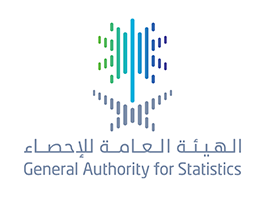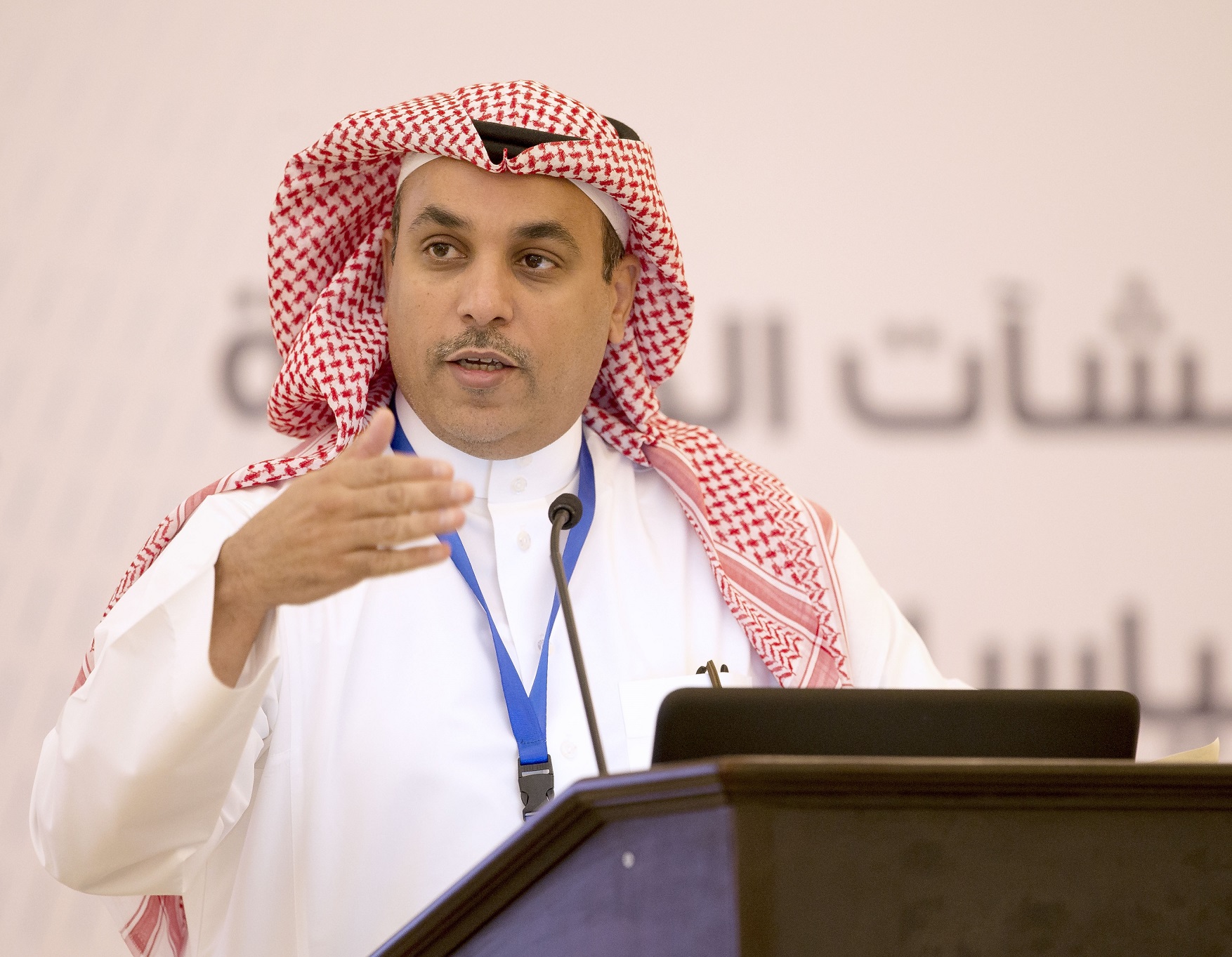
تشاركية بين " الهيئة العامة للإحصاء " والقطاع الخاص لتطوير العمل الإحصائي
announcing (6) new economic surveys to support development
Collaboration between GsStat and the private sector to develop statistical work
GaStat revealed new economic surveys to be implemented this year and next year. These surveys aim at fulfilling the development needs, they include: insurance activity survey, direct foreign investment survey, intermediate and small establishments survey, retail activity survey, non-profit sector survey, and tourism survey.
This was mentioned in the second workshop held by GaStat yesterday (Monday) 13th February 2017 in Jeddah. HE dr. Fahad bin Sulaiman Altekhaifi, GaStat president, said that the private sector is an essential partner in the national development. He added, it integrates all public sectors and institutions in a way that strengthens the national economy. The collaboration between "statistics" and the private sector is part of the developmental movements which aim at achieving the 2030 Saudi vision and representing that with indicators that reflect the progress in the achievement of this vision. The role of GaStat, statistical national commission, and the statistical sector in general became more important now as the need for accurate statistical data, effective indicators, and measurement tools increased. Dr. Fahad indicated that one of the most important stages that GaStat works on these days is meeting the clients' needs whether from the public or private sector. It also works on establishing effective collaborations locally, nationally, and internationally with related parties. In addition to creating indicators necessary for current and future needs. GaStat works with its partners on unifying the information sources, facilitating their access, and providing innovative statistical products with international standards.
On the other hand, Mrs. Kholoud Aldakhail, the national statistical commission chairman, stated that the commission was established under the umbrella of the council of Saudi chambers based on the Saudi chambers board resolution number 13 /88/m issued in 15/6/1437 H as response to the ministry of economy and planning and GaStat request. This reflects GaStat initiative to make the private sector a collaborative sector. She asserted that the role of this committee, which include 23 members who work in the field of statistics, data, and information, is represented in the coordination with Saudi chambers of commerce all over Saudi Arabia. The coordination will be about statistical work activation, data exchange, and proposing methods to enhance the statistical work impacts on the private sector. Furthermore, it deals with elaborating the use of statistics in private sector, deepen relations between GaStat and Saudi chambers of commerce.
The workshop discussed two main themes; the requirements of data users in the private sector as one of the statistical sector components, determining required additional data by activity, and the proposed methods to develop the mechanism of data collection from the private sector institutions. GaStat has presented the economic surveys and the new surveys that will be implemented by them during these two years. They also presented the six tracks based on which the authority work which can be summarized in; a work strategy about the authority clients and partners to fulfill the actual need of statistical products, then developing these products and services and improving the statistical operations and methodologies. Also, raising the level of information technology and digital infrastructure to enable products to start from a strong base that can be adapted with any change. Moreover, focusing on raising statistical awareness, and building capabilities in the statistical field. In addition to structuring all GaStat tasks and departments.
At the end of the workshop, dr. Fahad expressed his thanks to all the participants. He asserted that the workshop outputs will contribute in enhancing the effectiveness of the decisions made by the private sector and its policy makers for the citizen's advantage and society economies which enhance his role in the domestic product growth, and guarantee making proper decisions based on accurate data to facilitate measuring their result and reflections.
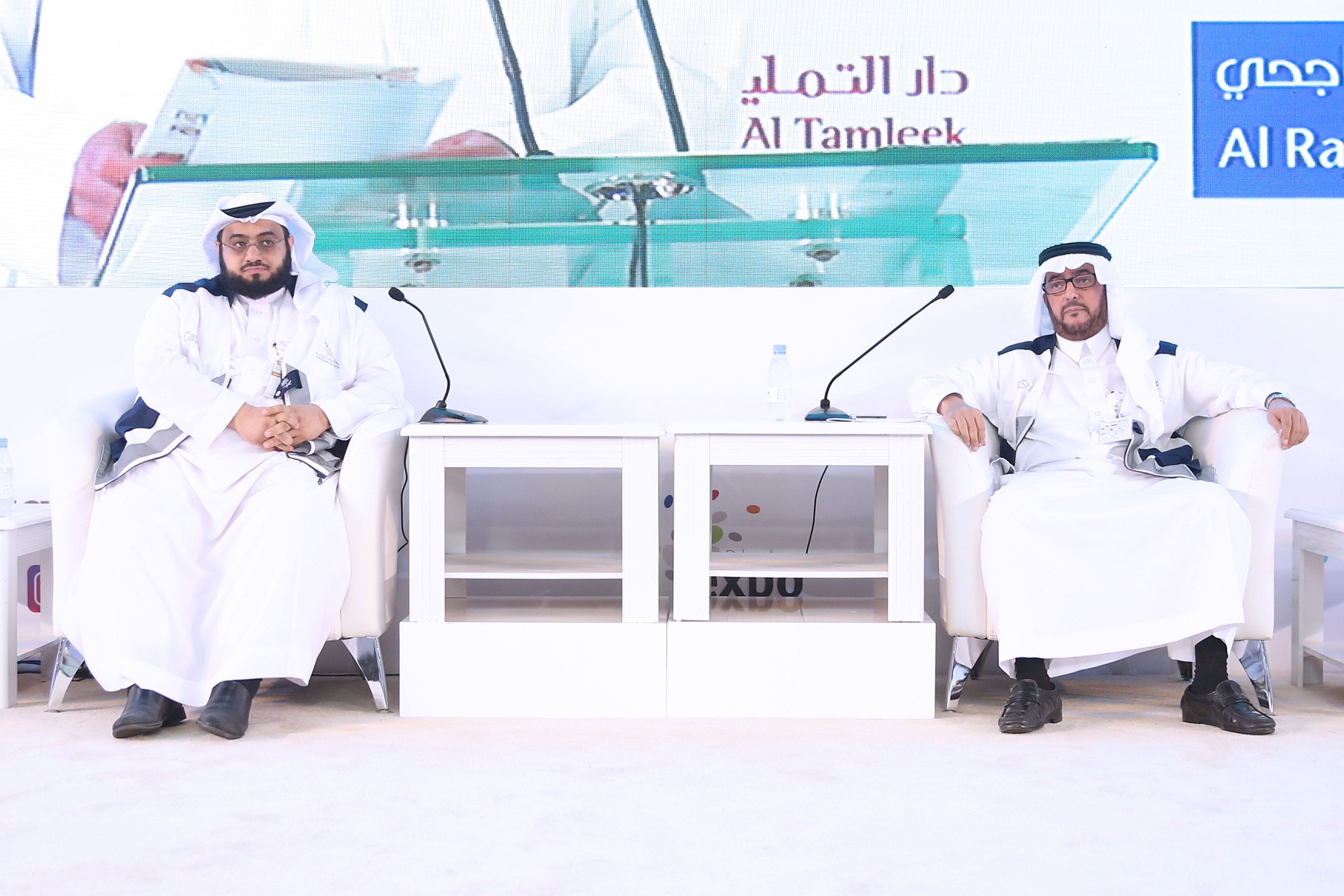
الهيئة العامة للإحصاء تطلق مؤشر الرقم القياسي للعقارات
Based on ministry of justice registry data
GaStat launches real estate index indicator
On Monday 18 Rabe'a second 1438 H corresponding 16 January 2017, GaStat launched the Saudi real estate index indicator. This indicator is based on available registry data of the ministry of justice that is about real estate transactions in 2015 and 2016. GaStat described this indicator as an essential tool that supports entities which make economic and statistical decisions associated with real estate price movements and future expectations during different periods of time. The indicator includes three main sectors composed of many real estate classes: residential sector ( piece of land, building, villa, apartment, and house) , commercial sector (piece of land, building, shop, and commercial center), and agricultural sector ( agricultural lands).
Real estate price index indicator showed a decrease in the Saudi real estate prices in 2016 compared to 2015 and 2014. The indicator registered a decrease of (6.1%) compared to 2015. Whereas it registered a decrease of (8.5%) compared to 2014.
During the fourth quarter of 2016, this indicator recorded a decrease of ( 3.5%) compared to the previous quarter. However, it recorded a decrease of (8.7%) compared to the same quarter of 2015.
The report attributed the decrease in the fourth quarter of 2016 (compared to the previous quarter) to the decrease in all composing sectors: commercial sector (4.1%), residential sector (3.4%), and agricultural sector (0.3%).
On the other hand, the decrease in the fourth quarter of 2016 (compared to the same quarter of 2015) to the decrease in all composing sectors: commercial sector (12.3%), residential sector (7.4%), and agricultural sector (1.1%).
GaStat indicated in a workshop ,held in " Restatex " exhibition in Dhahran city, that : as an official reference of statistics and an organizer of statistical sector in Saudi Arabia, one of Gastat tasks is follow up the price movement of real estate composing units and record the values of their transactions all over Saudi Arabia. In addition to monitoring their changes from time to time through the new statistical product " real estate price index" which relies on the data provided by ministry of justice. This represents the integration and cooperation between the different government entities which aim at moving sustainable development forward.
GaStat also stated that the new statistical product aims at founding distinct real estate statistical indicators that measure the Saudi real estate market performance and fill the gap of data in this sector. It is considered an essential tool that supports entities which make economic decisions in this field. This product's data benefit those who are interested in the economic and statistical analysis of real estate prices and the future expectations during different periods of time. GaStat has issued a complete bulletin about this index and its details on its website.
It is worth mentioning that GaStat has announced 45 new statistical products as a first stage of the new products which included economic, social, demographic, Umrah , and labor market statistics. In addition to energy, knowledge, environment, culture, sport, entertainment, safety, and security statistics.
Download: Real Estate Price Index Q4 2016 (PDF)
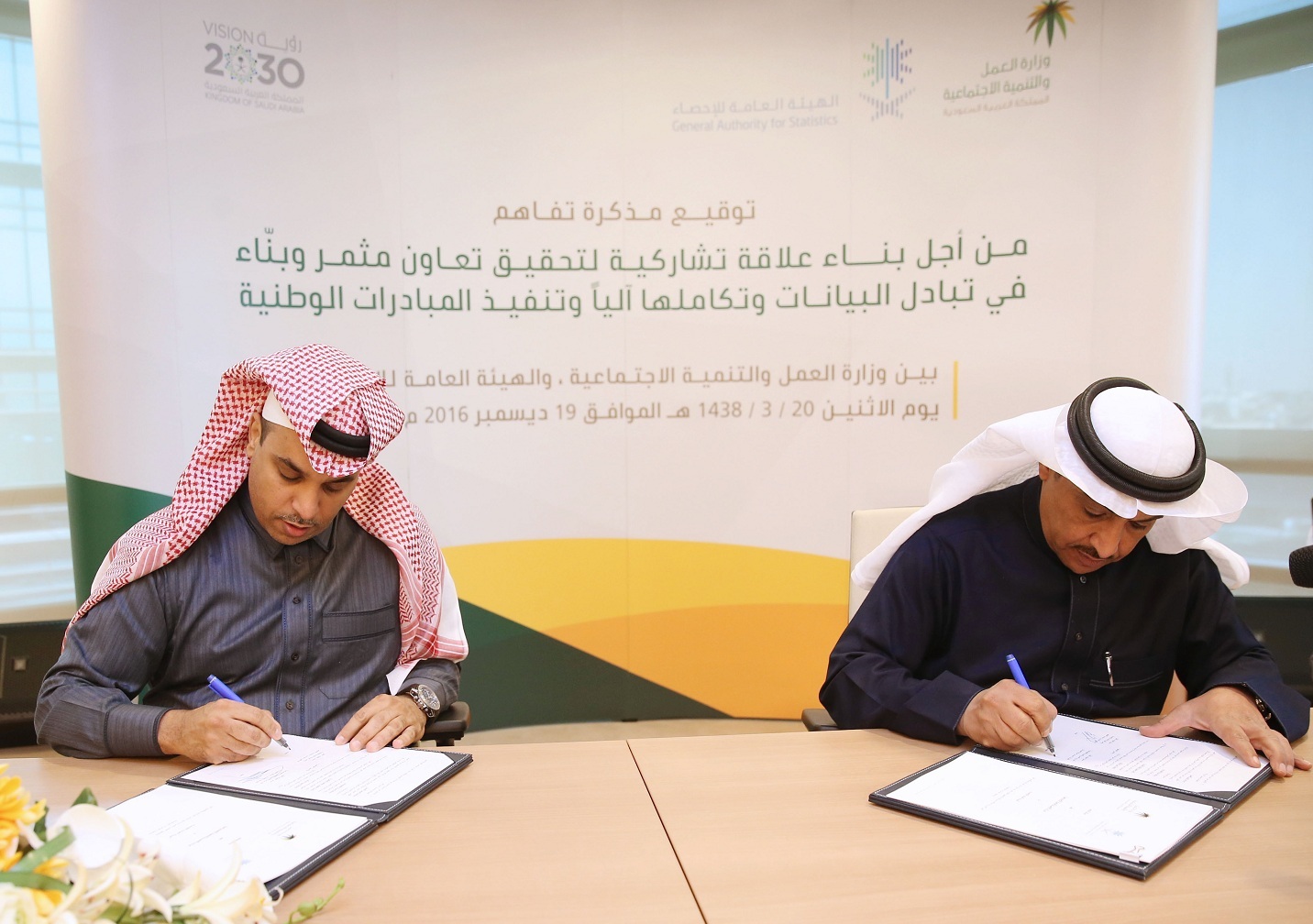
الهيئة العامة للإحصاء : نعمل على تطوير بيانات سوق العمل لدعم متخذي القرار
Signed a joint memorandum of understanding with the Ministry of Labour and Social Development
GaStat: We work on developing data of labour market to support decision makers
On Monday 20 Rabī‘ al-awwal,1438 corresponding to December 19, 2016 , GaStat signed a memorandum of understanding to develop electronic data exchange and integration and the implementation of a number of joint national initiatives relevant to the data of labour market in the Kingdom of Saudi Arabia. The national Labour Market Observatory and the "Labour Market bulletin" are considered the main outputs of this memorandum.
Mr. Taiseer Almofarrej, GaStat's official spokesman, clarified that the joint work in the field of data exchange with the Ministry of Labour and Social Development is a work in progress, and that the memo signed today by His Excellency Dr. Fahad Altekhaifi, GaStats President, and His Excellency the Deputy Minister of Labour and Social Development, Mr. Ahmad Saleh Alhomaidan in the framework of developing joint work, particularly after the merging of the Labour with Social Development is made to keep pace with the new changes in this field. Emphasizing on the importance of collaboration to provide statistical services that support decision makers and users by providing statistical data and information that is immediate, comprehensive, reliable and flexible in the best interest of beneficiaries either citizens or residents. Almofarrej stressed that the reinforcement of collaboration between GaStat and the Ministry is based on developing entire statistical products related to labour force, social development, establishments, statistical data exchange and integration and the integration of work at the relevant national observatories. The joint work also includes the unifying of standards, classifications and definitions of labour force, social development and establishments. The memorandum contributes in achieving the goals of the social development national strategy, the Saudi employment strategy, the tenth development plan, the privatization strategy and the national strategy of statistical development.
GaStat's official spokesman also asserted that most important outcomes of this collaboration is: the support of statistical data production and dissemination through surveys and administrative records carried out by GaStat and the Ministry on a regular basis, total coordination regarding labour force statistical data dissemination, facilitate cooperation in the exchange and flow of information, the development of Saudi labour market data system through providing a statistical database that is highly accurate to be used by decision makers, planners, researchers and relevant entities, unify efforts to ensure getting accurate statistical data for the most important indicators of the labour market and social development which contribute in the measurement of the 2030 Saudi Vision and the 2020 national transformation program, meet the requirements of the beneficiary entities, the collaboration in establishing a databases for GaStat which are not-for-profit, associations and charities, cooperative committees and social development centers, the collaboration and coordination to reinforce the specialized observatories currently in place, establish and prepare new statistical products specializes in the labour market and social development issues.
On the other hand, Mr. Taiseer Almofarrej clarified that GaStat is currently working in collaboration with the Ministry of Labour and Social development, Ministry of Civil Services, Human resources Development Fund and the General Organization for Social Insurance to develop the labour market data through the production of "Labour Market Bulletin" to be a periodic integrated bulletin that meets the demand for suitable trained and qualified manpower , and the supply side of the population of who are capable of working and willing to search for a job at certain period of time. The bulletin will be the updated version of the quarterly Labour force Survey results conducted by GaStat.

"المملكة" اتخذت خطوات فعالة لتنفيذ خطة أهداف التنمية المستدامة ٢٠٣٠ المقرَّة من الأمم المتحدة بما ينسجم مع خطط التنمية الوطنية وخصوصيتها
At the end of the 29th session of "ESCWA" held in Doha
Dr.Altekhaifi: the "Kingdom" has taken effective steps to implement the plan of the 2030 sustainable development goals approved by the United Nations in line with the national development plans
The United Nations Economic and Social Commission for West Asia (ESCWA) has recently ended its 29th ministerial session entitled "Implementing the Sustainable Development Goals of 2030 in Arab countries". Where the whole participants came together in order to implement the 2030 sustainable development plan, taking into account the particularities of the regions and its development priorities. The chairman of the Saudi Delegation participating in the Session, GaStat President, H.E. Dr. Fahad Altekhaifi mentioned that the Arab region countries faces multiple challenges in the implementation of the " the plan of the Sustainable Development Goals of 2030" approved by world leaders approximately year ago. These challenges include economical and social, political, developmental challenges. The most prominent of these challenges is the statistical challenges related to building indicators that measures the progress of the(17) goals and its (240) indices according to latest update in (May) 2016.
His Excellency explained that one of the most important factors that will help in the implementation of the sustainable goals plan is the state's ability to develop its development plans to adapt with the international plans, provided that they do not violate the Islamic shari'aa law and suits Saudi Arabia.
His Excellency assured that the Kingdom of Saudi Arabia worked in two tracks to implement the goals of the 2030 sustainable development approved by the United Nations: the first track is developing a governance to track the implementation of plan, and it was assigned to the Ministry of Economy and Planning who will be responsible of the management of this file, follow-up, coordinate with all government entities, assigning government entities to follow-up with the goals within their competence. In addition, GaStat builds these indicators through the expansion of statistical work implementation either through designing new statistical surveys, develop current surveys, or build indicators from the data collected from the records of other government entities. The second track that Saudi Arabia worked on is developing its national development plans (Saudi Vision 2030), and connect it to the global plans(sustainable development plans). The 20130 Saudi vision and its (13) programs such as 2020national transformation program, government entities restructuring, projects managing program and other programs, and its (24) indicators, took into account the compatibility with the goals of sustainable development.
On the other hand, Dr. Altekhaifi stressed the Doha announcement in the end session of the 29th meeting of ESCWA to invite all States to provide adequate support to update statistical systems to produce data necessary to measure the progress in achieving the goals of sustainable development. Furthermore, promote dialogue between policy makers and data producers and users to record progress in implementing national and international plans. Finally, support the initiatives of some Arab countries to for the adoption of national strategies for the development of statistics.
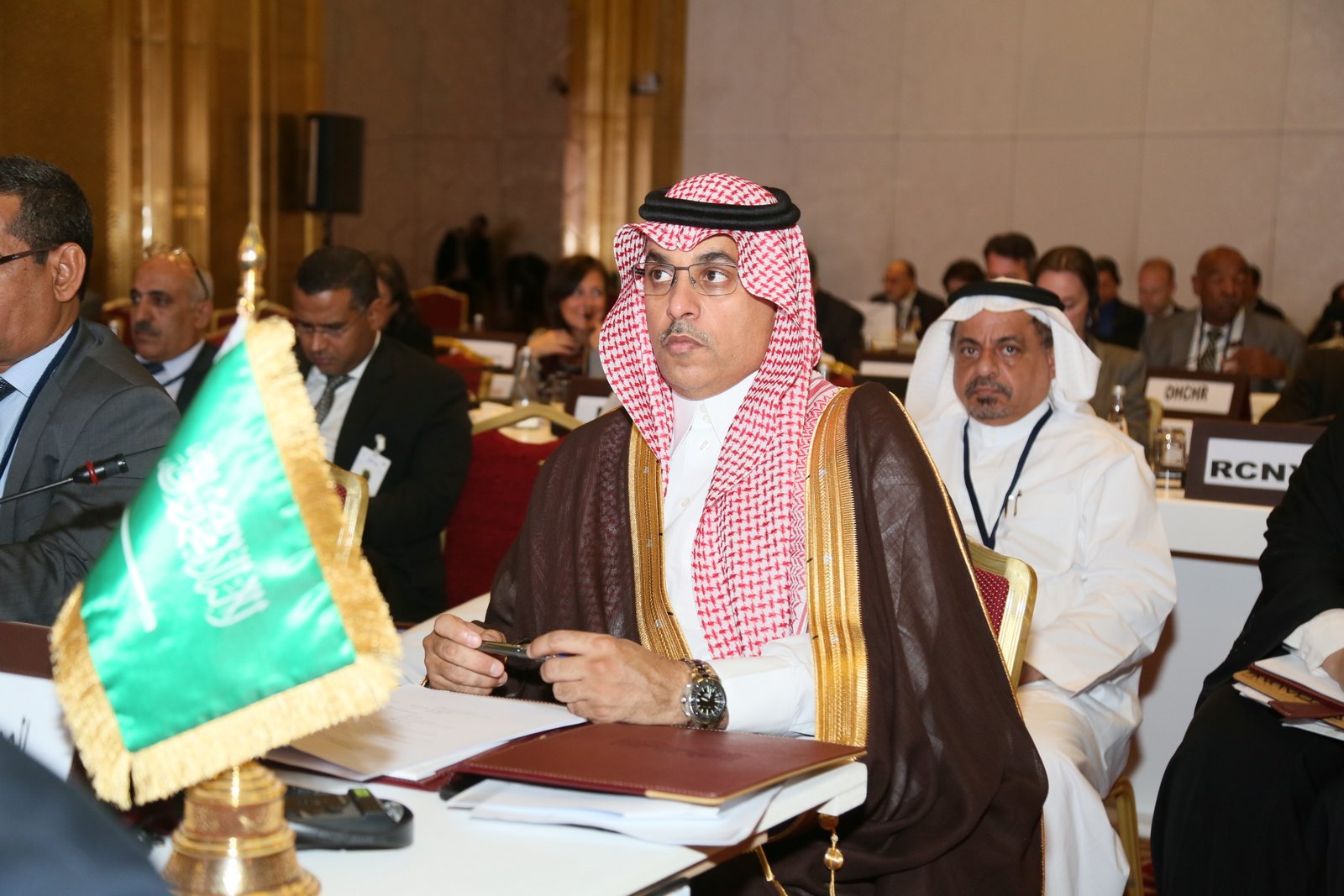
د. فهد التخيفي : الانتقال إلى مجتمع المعرفة يعزز التنمية المستدامة في المملكة
As the Chairman of the Saudi Delegation in the ESCWA Ministrial Session
Dr. Altekhaifi: the transition towards a knowledge-based society promotes sustainable development in the Kingdom
H.E. Dr. Fahad Sulaiman Altekhaifi, GaStat President, assured that the Kingdom of Saudi Arabia has completed remarkable steps towards achieving the millennium goals of sustainable development and has developed a strategy for total development under the framework of its 2030 Vision.
This came during the 29th ministerial session of ESCWA entitled "Implementing the Sustainable Development Goals of 2030 in Arab countries", held in Doha,Qatar. HE GaStat President chaired the Saudi delegation participating in this session. He clarified that the Kingdom has made deliberate steps towards achieving the goals of sustainable development, where all conditions are prepared to achieve its goals of growth rates, average income increasing, promote the transition towards a knowledge-based society. This can be made through multiple strategies such as those based on economic diversification, sovereign investment funds, support the private investment initiatives, invest in quality education, research and development, health facilities, public services, and international and regional agreements. He added that the entire government systems in the Kingdom works on increasing the development of national and regional institutions, and enhance coordination efforts, enhance the flexibility of public institutions in developing governance strategies.
On Tuesday, The United Nations Economic and Social Commission for West Asia (ESCWA) held its 29th session for senior officials, in the presence of representatives from member states and non-member states in international and regional organizations and committees.
ESCWA is one of the five United Nations' regional commissions, and is a part of its general secretariat. It works under the supervision of economic and social council in order to support the economic and social cooperation between the region countries and promotes the development process in order to achieve regional integration.
Its membership compromises of 17 member states which are: Saudi Arabia, Bahrain, Egypt, Iraq, Jordan, Kuwait, Lebanon, Libya, Morocco, Oman, Palestine, Qatar, Sudan, Syria, UAE, Tunisia and Yemen.
The ESCWA ministerial session is held every two years with the participation of the commission member states representatives on the mistrial level and representatives from United Nations' organizations and programs in addition to United Nation member states who are not member of ESCWA.

الهيئة العامة للإحصاء: 5,382 مصوِّر يعملون في 2,415 محل تصوير فوتوغرافي في السعودية
Within the new bundle of cultural indicators
GaStat: 5,382 photographers work in 2,415 photography studios in Saudi Arabia
On Sunday, 12 Rabī‘ al-awwal 1438 corresponding to December 11, 2016, GaStat issued its indicator about the number of photography studios and its workers from 2011 to 2015 in all administrative regions of the Kingdom which has reached 2415 studios with 5382 photographer and workers.
The indicator issued by GaStat showed that Makkah region is in the lead by number of photography studios and its workers for the last five years. The number of studios in Makkah region has reached more than 802 in 2015, while Riyadh region is the second largest area after Makkah in the number of operators and photography studios which has reached more than 640 studios with more than 1400 worker in 2015.
GaStat's spokesman Taiseer Almofarrej explained that the photography indicator is considered one of the most important cultural indicators, and it measures the changes in number of shops that photograph people, number of photographers, and number of workers annually. The indicator reflects the development in photography activity in different regions of the Kingdom.
Almofarrej stressed that GaStat was keen to launch its indicator today to cope with the events of "colors of Saudi Arabia forum" to shed light on this activity. He also added that after the launch of any indicator, GaStat begin its assessment in order to develop the indicator with the collaboration of relevant entities. One of these indicators is the photography as one of the most important cultural indicators, in addition to the fact that photography field is one of the attractive fields to work in especially with the development of photography tools and the increasing demand on photographers, and the impact of images on media, art and culture particularly with the spread of social media. Knowing that the indicator does not include amateur photographers or who works independently as the indicator relies on record data from relevant entities.
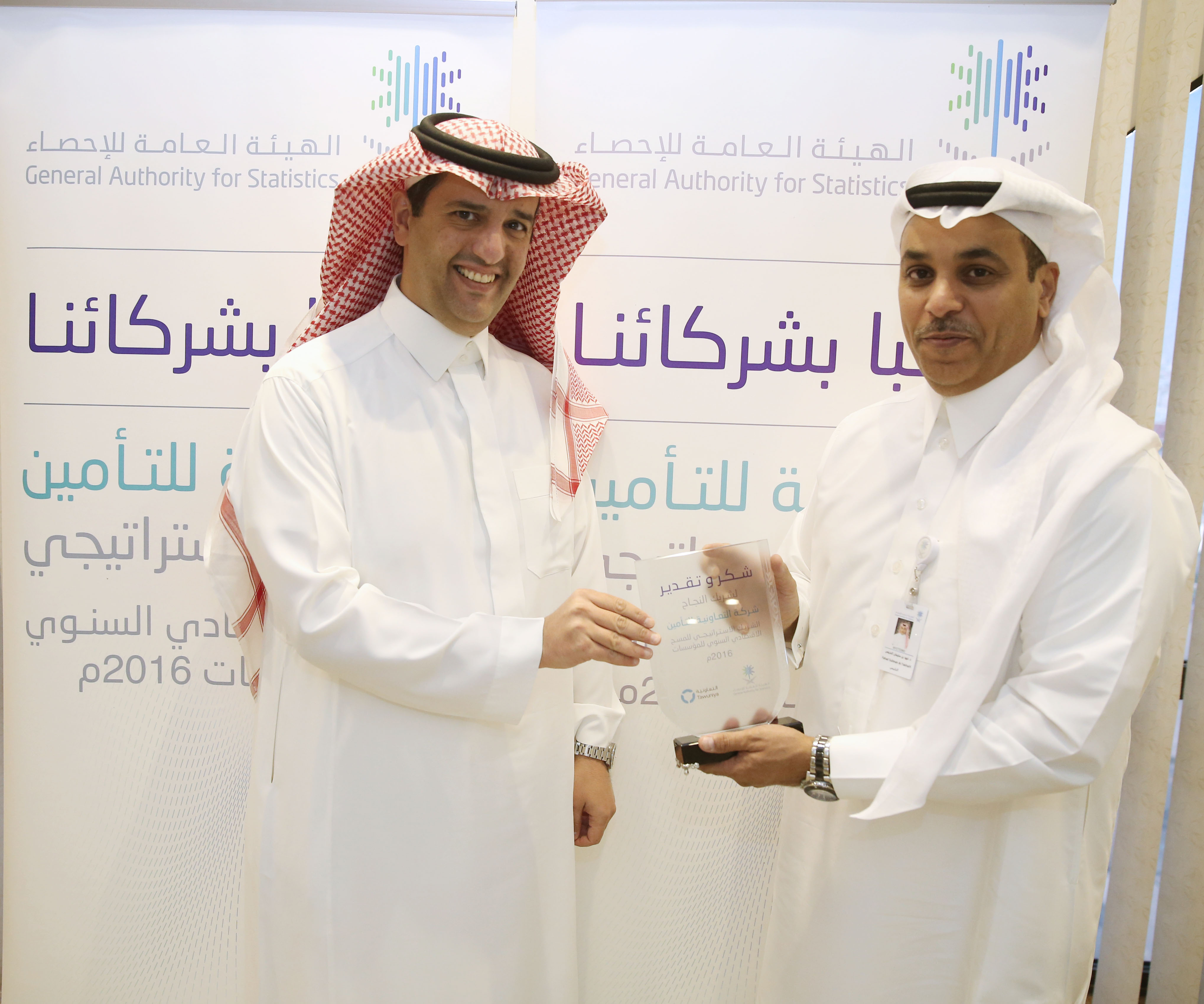
الهيئة العامة للإحصاء تكرم التعاونية للتأمين
For its role in raising statistical awareness within the economic survey
GaStat honours Tawuniya
H.E. Dr.Fahad Altekhaifi, the President of the General Authority for Statistics (GaStat), expressed his thanks to Tawuniya insurance company for supporting the operations of the economic survey of establishments (2016) that aim to support statistical awareness programs.
H.E. GaStat President stressed that giving the opportunity for the private sector to sponsor specialized surveys and research comes within the framework of enabling the support of statistical awareness, in which Gastat aims to raise the awareness of any research or study targeted groups to the importance of the information provided and its role in supporting relevant development decisions. He added that the private sector in the Kingdom of Saudi Arabia realizes its societal role and offers a number of supporting initiatives to achieve the goals of government agencies.
Dr. Altekhaifi explained that in this year, GaStat conducted its periodic economic survey through a series of economic research and surveys in order to provide detailed economic data of all establishments in the private and public sector and non-profit organizations to prepare indicators that help in recognizing the economic activities growth rate. More than 650 statistical researchers collected the data of 33,500 establishments in all regions of the Kingdom in order to obtain detailed economic data related to different aspects of the establishment.
Mr. Raed bin Abdullah Al-Tamimi, Tawuniya CEO, expressed pride in the strategic collaboration with GaStat through his visit to GaStat. He clarified that this sponsorship is part of the initiatives of Tawuniya to support the statistical awareness of the Saudi society because of the importance of its results in the development of the private sector. Mr. Al-Tamimi expressed his thanks to Gastat for giving them the opportunity to contribute in achieving the objectives of economic statistical products that supports the economic projects.
Mr. Al-Tamimi added that Tawuniya, as the leading insurance industry in the Kingdom, supports the economic projects especially small and medium enterprises and national authorities to complete the initiatives that have a positive impact on the society and insurance sector. He noted that Tawuniya has a great experience in insurance practices and provides a variety of insurance solutions that meet the needs of all business sectors, drawing attention that this approach is in line with the 2030 Saudi Vision.
Al-Tamimi asserted the importance of providing economic information about economic establishments to support decision makers in drawing a clear roadmap that contributes in implementing the goals and plans of the national transformation program. This program supports the role of economic establishments especially small and medium establishments in the GDP at a rate of up to 25% in 2020, which will contribute to reduce the dependence on oil and diversify sources of income.

د. التخيفي: الهيئة العامة للإحصاء تعمل على تعزيز الشراكات المحلية والدولية بهدف رفع جودة البيانات لدعم متخذي القرار وراسمي السياسات
Participating with 40 countries in the International Association for Official Statistics (IAOS) conference
Dr. Altekhaifi: GaStat works on enhancing the national and international collaborations to raise the data quality and support decision and policy makers
GaStat participates in IAOS conference 2016 (round 15) Under the Patronage of H.H. Sheikh
Hazza bin Zayed Al Nahyan, Vice chairman of Abu Dhabi executive council. The conference is organized by Statistics Center in Abu Dhabi. The main theme of the IAOS 2016 conference is "The Spirit of Official Statistics: Partnership and Continuous Innovation". The conference activities will conclude on December- 8-2016.
Dr. fahad bin Sulaiman Altekhaifi, GaStat president, said that the authority keeps enhancing its experience and raising the data quality through an integrated program for all local, regional, and international collaborations, in addition to following the best international practices in order to provide comprehensive and high-quality statistical data that support policy and decision maker. He revealed that the strategic collaboration program is an essential part of the statistical sector' strategic transformation program in Saudi Arabia. GaStat worked on preparing a transformation map in the statistical work. This map included a number of projects and initiatives that cope with the 2020 national transformation program and 2030 Saudi vision. The statistical transformation project depended on three main dimensions; quality of statistical products, concentrating on clients, and activating the statistical sector. Using these three dimensions, GaStat went through six main tracks represented in reformulating the authority tendencies in a way that achieves the goals and reflects the clients tendency, reevaluating the products and services provided by the authority, determining the required operating activities to provide products and services according to clients needs, enhancing the technical part in the authority, modifying culture and developing statistical awareness, in addition to assuring the existence of the organizational structure and the governance to make a transformation. Each track has a group of projects and initiatives that are integrated with each other, so that they can contribute in implementing the strategic transformation program. These projects and initiatives aim at activating the statistical part, evaluating the products and services, and developing methodologies, standards, and classifications. This can be achieved after preparing the authority administratively, financially, technically, and systematically to pursue in the transformation process. In addition to raising the statistical awareness and culture among all users of data, information, and statistics.
On the other hand, Dr. Fahad asserted that IAOS conference was held in a time, during which all GCC statistical entities work together to achieve the vision of the custodian of the two holly mosques that enhances integration between GCC countries, improves GCC statistical performance, and meets the leaders expectations. All GCC statistical entities work on supporting the integrated work especially the collaboration between them, so that they can deal with all GCC essential issues.
GaStat participation in this conference represents its belief in collaboration and how it develops the statistical work and raises awareness among all producers and users of data. Moreover, it identifies the importance of official statistics and how they support the developmental resolutions in the region. Altekhaifi clarified that GaStat along with all GCC statistical entities are trying to enhance and develop the concept of official statistics so that they reach an excellent level of efficiency. Furthermore, they enhance the value of official statistics in the information community. They also enhance collaborations, innovation, and national statistical system update.
H.E. expressed his gratitude for the great hospitality of Abu Dhabi in this conference. It is the first country in the region that organizes an IAOS conference, as this conference is held every two years by one of the IAOS members. So, this assured the GCC statistical entities role in the region.
It is worth mentioning that the 15th round of the conference depends on four main aspects, about which all sessions are conducted. The aspects are: enhancing the value of official statistics in the information community, making collaborations to achieve results, innovation and updating national statistical systems, and following the main principals in the statistical work practice.
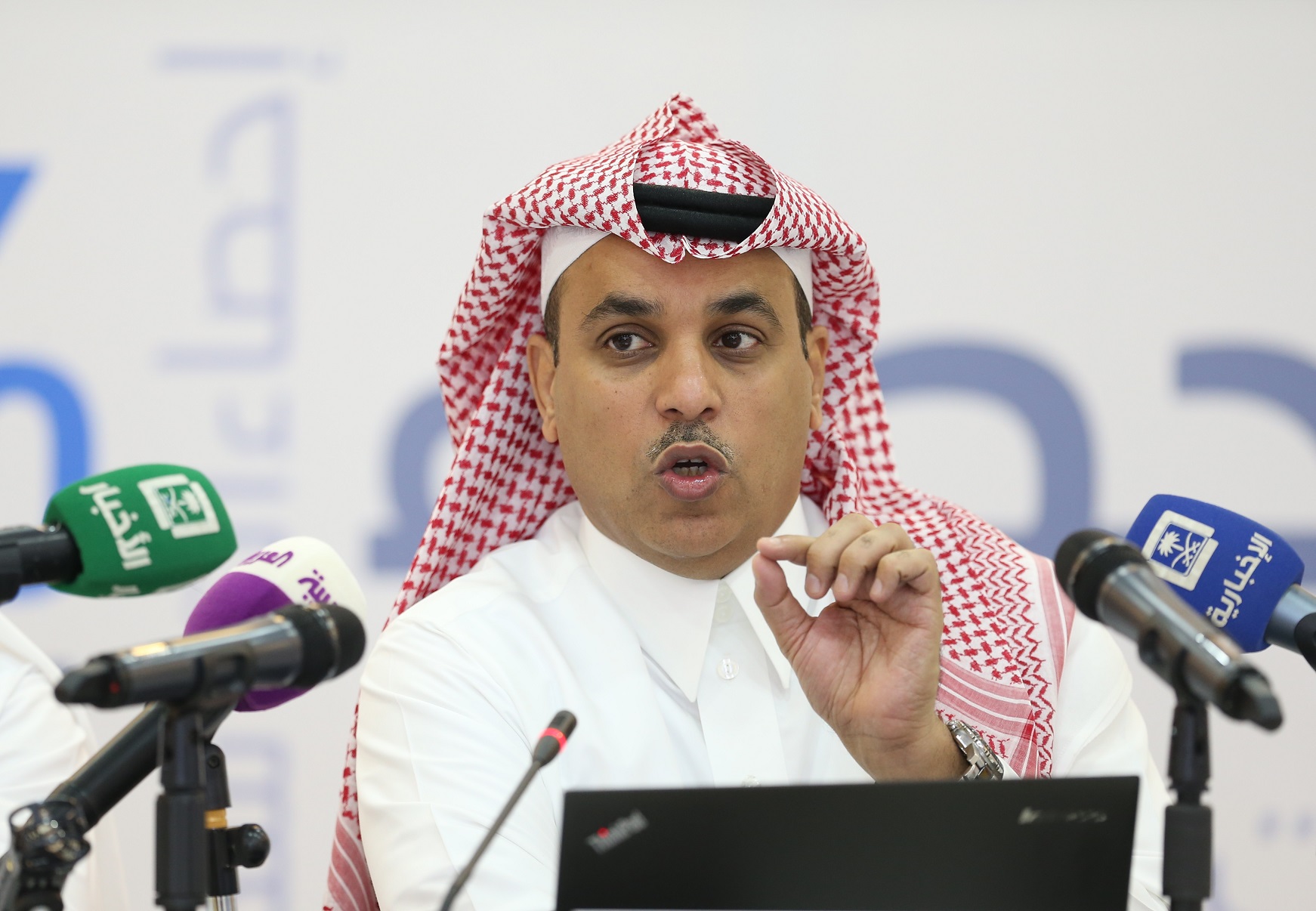
الهيئة العامة للإحصاء تطلق أكثر من 45 منتج إحصائي جديد
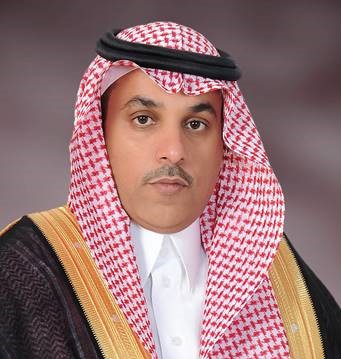
معالي رئيس الهيئة يثمن موافقة مجلس الوزراء ويؤكد على استمرار العمل الإحصائي لدعم قرارات التنمية
The application of GOSI's staff regulations and pay scale on the staff of GaStat
H.E. the President of GaStat appreciates the approval of the Cabinet and confirms the continuation of the statistical work to support development decisions
H.E. the President of the General Authority for Statistics, Dr. Fahad Bin Sulaiman Altekhaifi, appreciated the approval of the Cabinet in its meeting on Monday, 30th of Muharram 1438H on the application of GOSI's staff regulations and pay scale on the staff of GaStat.
H.E. expressed his gratitude to His Highness the Custodian of the Two Holy Mosques, King Salman Bin Abdulaziz Al Saud, and His Highness the deputy Crown Prince for the support given to all government entities to achieve its objective in national development. It reflects the care of the prudent leadership for developing the infrastructure of all development resolutions, considering the statistical products and services provided by GaStat as a solid bases to support national development decisions, and support decision makers with information that is considered the compass of development work. H.E. stressed that the application of GOSI's staff regulations and pay scale helps GaStat to adapt to next phase requirements and allows them to attract specialized national talents in the statistical and administrative work in an effort to complete the transformation, which started after the Royal Decree No. (64283), dated 26/12/1436H, approving the transformation from (Central Department of Statistics and Information) into an independent Authority. This transformation helped in enhancing the environment to provide a wider range of statistical information and data and its dissemination to support decision making. Since the Royal Decree issuance, GaStat worked on the preparation of a transformation road map in statistical work including a number of projects and initiatives that are consistent with the 2020 National transformation Program, and the 2030 Saudi Vision.
It is worth mentioning that the modification, on which the cabinet has agreed, was listed as ( the second) item of the cabinet resolution of the General Authority for Statistics organization, number (11) in 13/01/1437 H. The resolution was modified to be as following " except the authority president, GOSI regulations, pay scales, and modifications are applied on GaStat staff". The organization included (17) terms covering a group of organizational rules, the most important of which are: stressing on the authority's legal personality, administrative and financial independency, and asserting that it is the only statistics- concerned entity. Moreover, it is the only official reference that supervises and organizes the statistical work. The authority's affairs are managed by a board that contains (18) entities, (13) of which are government entities including the authority, in addition to the council of Saudi chambers, and two independent statistics specialists. The board is headed by HE minister of economy and planning, and has been given the description of " the dominant authority" which means implementing its resolutions on the level of statistical sector and all its components in Saudi Arabia. The organization has charged the authority with the responsibility of forming a coordination committee that constantly coordinate the statistical work between the authority and the other related entities. The authority will also carry out the responsibility of founding an information central system in the authority that is automatically linked with all concerned entities. Furthermore, the organization included many tasks in addition to implementing the statistical works such as: applying the recognized international standards which include the statistical work methodology, designing and implementing surveys, conducting research and studies, analyzing data and information, documenting data, collecting, recording, classifying, and analyzing statistical data ,which cover all aspects of life in Saudi Arabia, from its different sources either from surveys, censuses, or administrative records in the public and private establishments. Moreover, the tasks include preparing, using, and updating the national statistical guides and classifications according to international standards, preparing and publishing the surveys and researches' statistical reports and bulletins, providing statistical services, conducting surveys, preparing statistical studies and researches to provide the establishments and business sector with statistical data from its databases. In addition to the tasks of exchanging knowledge, providing the entities with recommendations to improve all information systems and statistical work methodology, so that they can have a unified, accurate, and comprehensive statistical system. The tasks also cover raising awareness about the importance of statistics, recording and following any statistics related to Saudi Arabia published by the national and international authorities, and coordinating with the concerned entities.
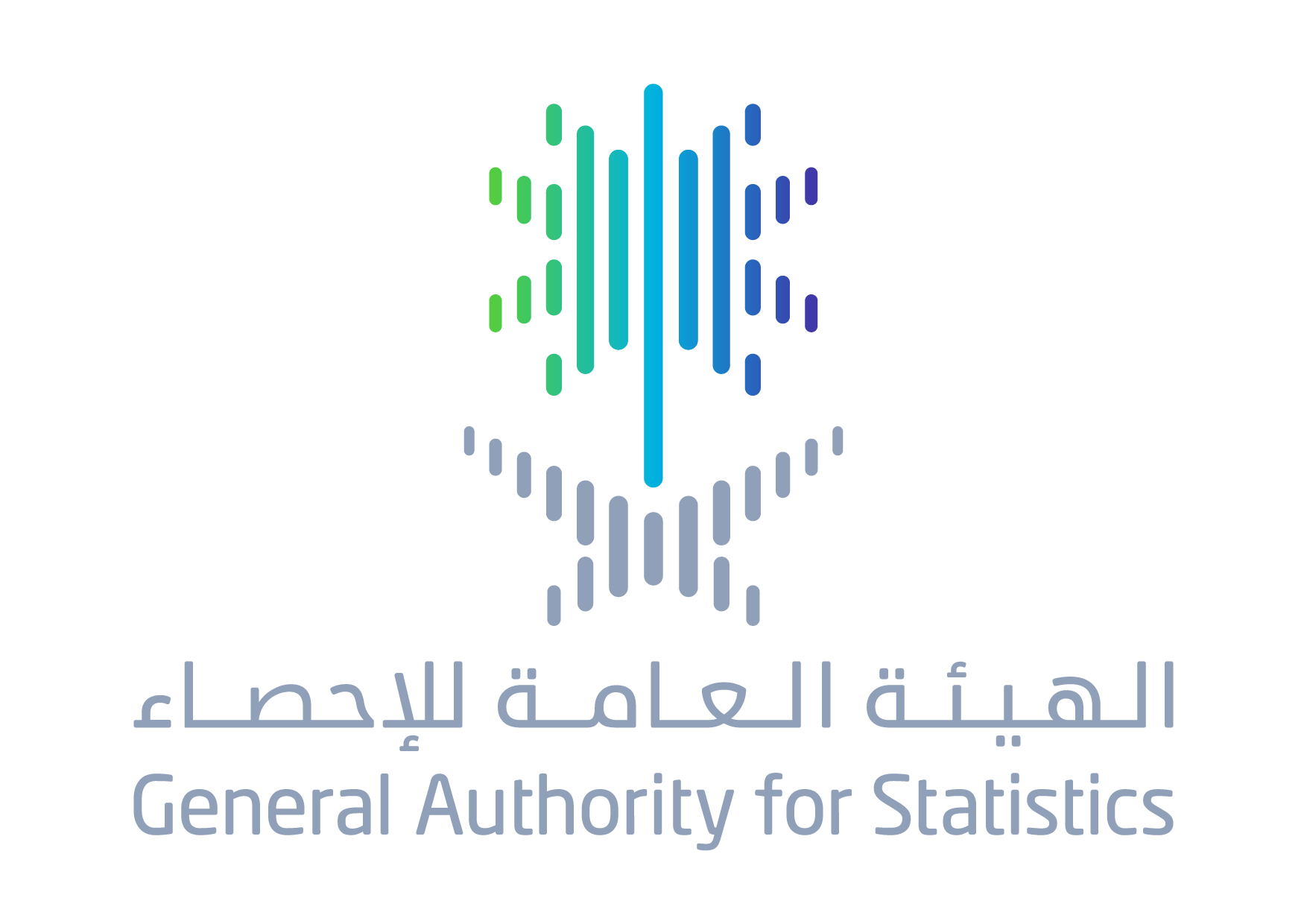
الهيئة العامة للإحصاء : ارتفاع الرقم القياسي لأسعار الجملة لشهر سبتمبر
GaStat: Wholesale Price Index Increases in September
On Tuesday, the 24th of Muharram 1438 H/ 25th of October 2016 AD, the General Authority for Statistics (GaStat) issued the monthly indicator of Saudi wholesale price index for the month of September. It is now published on its website www.stats.gov.sa . The indicator recorded (163.1) with 0.3% increase in September 2016, compared to last month (August) in which it recorded (162.6).The indicator includes ten main sections; Food and living animals section, beverages and tobacco section, raw materials except fuel, mineral fuel and related products section, Fats and oils section, chemical materials and related products, manufactured commodities classified by material section, transportation equipment and machines section, diverse manufactured commodities section, and other commodities section.The report attributed that increase to the rise of three main sections that constitute this indicator; transportation equipment and machines section with (0.9), Food and living animals section with (0.6%), manufactured commodities classified by material section with (0.1%).On the other hand, six sections have decreased: raw materials except fuel section with (1.4%), diverse manufactured commodities section with (0.4%), beverages and tobacco section with (0.3%), Fats and oils section with (0.3%), chemical materials and related products with (0.1%), other commodities with (0.1%), However, the sections of mineral fuel and related products did not change and remained stable.The authority indicated that the Saudi wholesale index measures the average of change in the prices of commodities and services that are sold in the primary markets. What matters here is the price change only. Therefore, the changes that result from the differences in quality, quantity, shipping method, or any other influencing factor in order to get the net price are excluded. This index is provided to everyone, and conducted all over Saudi Arabia.It is worth mentioning that the wholesale price index is used to record any change in the prices of local or imported commodities. In addition to monitoring the price directions and the status of markets and costs of living. Furthermore, it is used in preparing the national accounts by protecting the income and national aggregates from the influence of price change.
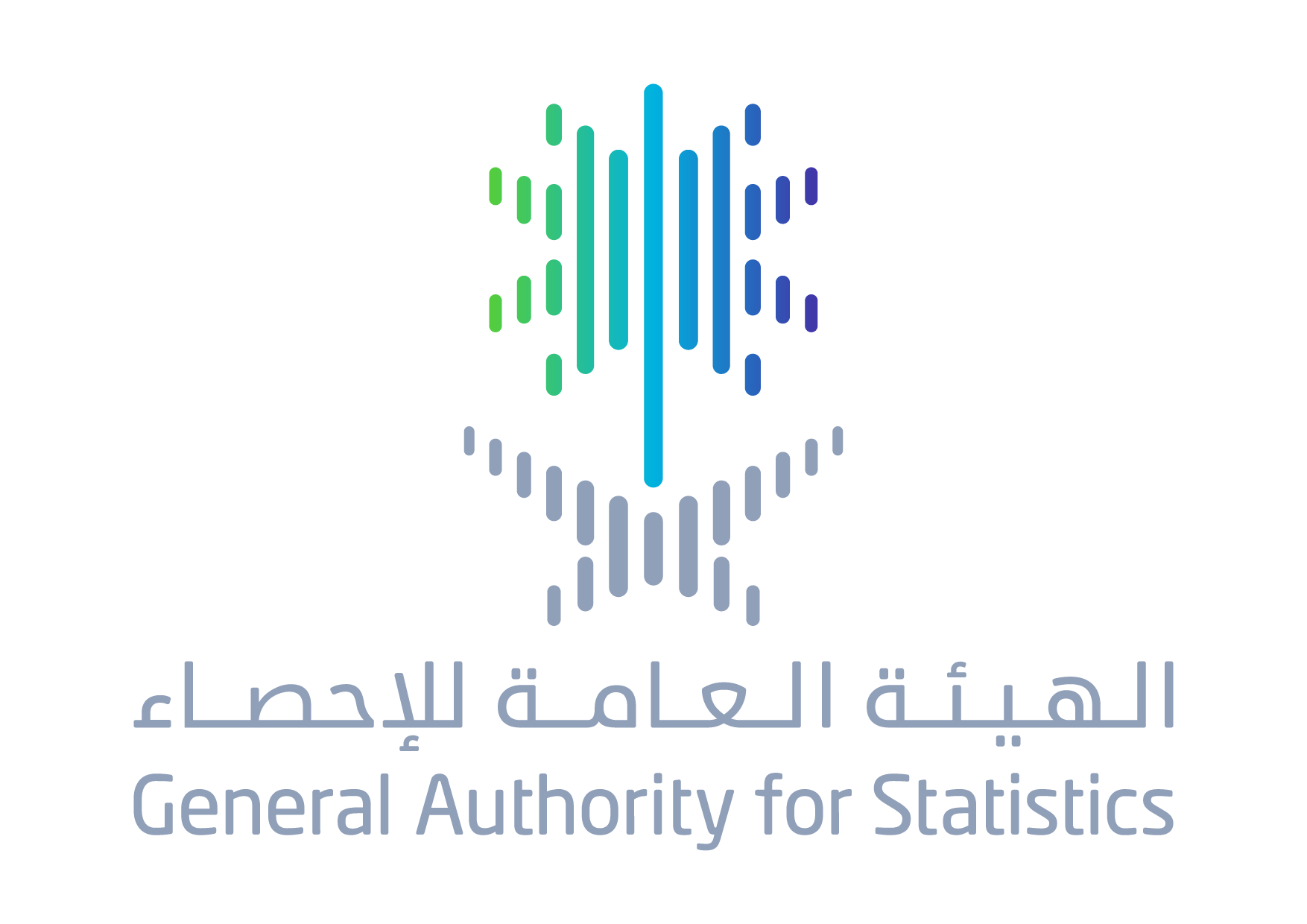
" الإحصاء “: استقرار مؤشر الرقم القياسي لتكلفة المعيشة لشهر سبتمبر الماضي
(6) sections decreased, and (4) rose.
"GaStat" : Cost of Living Index remains stable in September 2016
On Monday, the 23th of Muharram 1438 H/ 24th of October 2016 AD, the General Authority for Statistics (GaStat) issued the monthly indicator of Saudi cost of living index for the month of September. It is now published on its website www.stats.gov.sa .The indicator didn't record any relative change compared to the previous month.The monthly report indicates that the Saudi cost of living index indicator recorded (137.9) in September 2016 without any relative change compared to August 2016. It recorded an increase above (133.9) from September 2015, recording a rise of 3.0% on an annual basis.The report attributed the monthly increase to the rises of four of the main sections that constitute this indicator; clothes and shoes section with (0,7%), food and beverages with (0.3%), telecommunication section with an increase of (0.2%) , and finally, furniture ,appliances, and maintenance with an increases of (0.1%).On the other hand, six sections have decreased; commodities and services with a decrease of (1.0%), restaurants and hotels with a decrease of (0,7%), literacy and recreation with (0.4%), transportation with a decrease of (0,2%), housing, water, electricity, gas, and other types of fuels with a decrease of (0.2%), finally, health section with (0.1%).However, the sections of tobacco and education did not change and remained stable.The cost of living index indicator issued monthly by GaStat aims at providing data about the prices of commodities and services that are in the consumer basket. It also aims at providing data about the cost of living indices within a time series. (The consumer basket) refers to the actual group of commodities and services that are recorded during the household expenditure and income survey. The relative distribution of the commodities and services consumption inside the consumer basket is extracted to make it the base stone in the process of indices calculation. The cost of living indices are used to measure any change in the prices of commodities and services that are purchased by consumer. Moreover, it is used as an accurate indicator that measures the economic inflation and recession. It is also used in statistical and economic analyses that are associated with prices movement and anticipations in different times. Data are collected by conducting interviews. The sources addresses are clarified to the interviewers to facilitate their task. The sources distribution in one city must cover all available commodities and services with all levels.
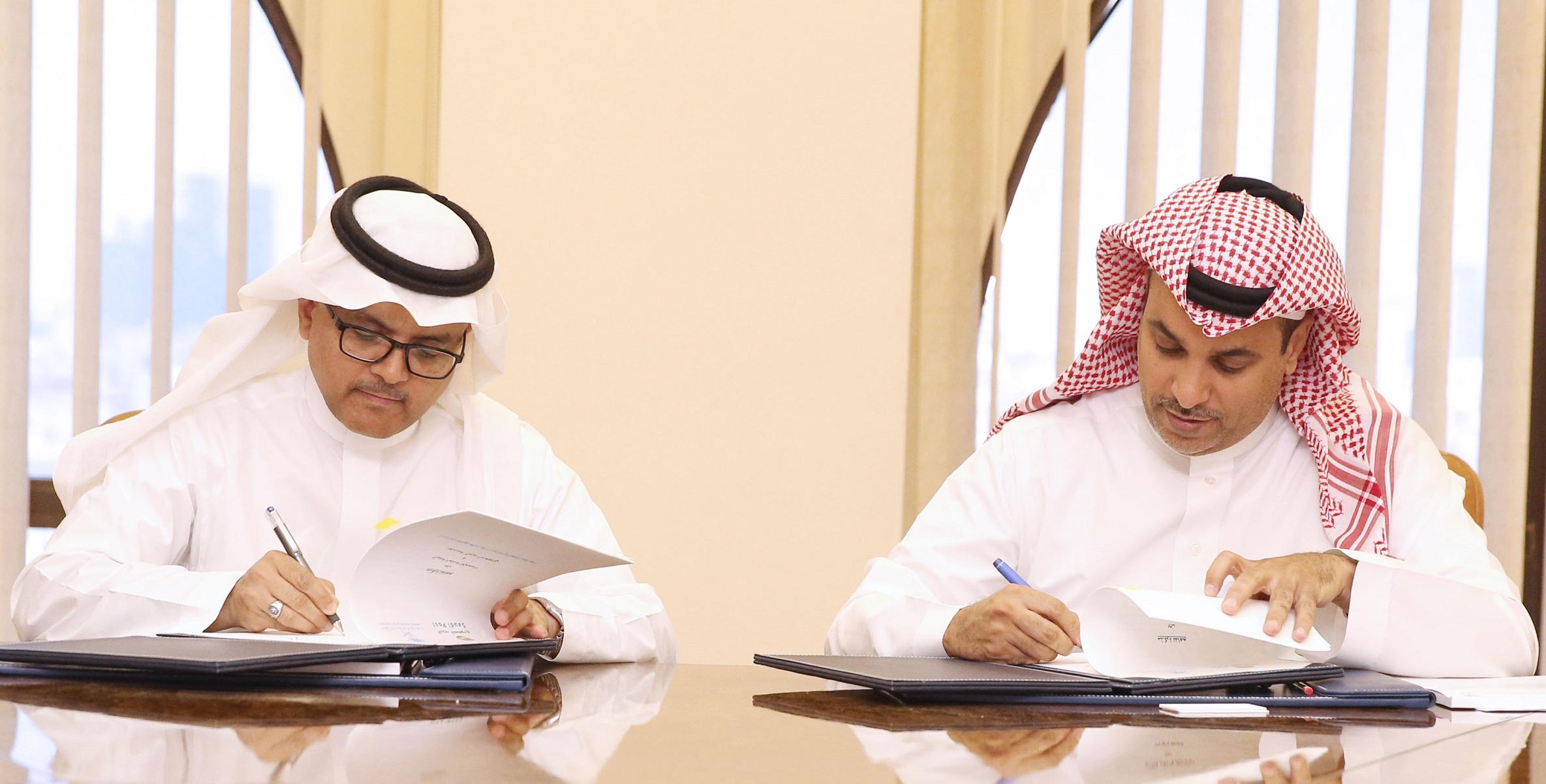
" العنوان الوطني " يربط البيانات بالموقع لرفع جودتها ويؤسس مرجع مكاني موحد للإحصاءات
GaStat and Saudi Post Institutions Sign a Memorandum
" National Address" Links Data with the Website to Raise Its Quality, and Establishes a Statistics Unified Spatial Reference
GaStat starts using the national address map, which is verified by Saudi post institution, to be the base of the statistical data collection operations. It also links the data of national address in the statistical field operations. On Sunday, 22 of Muharram 1438 H, GaStat and Saudi post institution signed a memorandum to enhance the collaboration between the two entities and activate the use of national address as a geographical base of data and statistics in Saudi Arabia, so that it can be used in the 2020 population and housing census.
Dr. Fahad bin Sulaiman Al-Tukhaifi, president of the General Authority for Statistics, said that the collaboration with Saudi post institution is all about producing and using the geospatial data and link them with the statistical data through surveys and administrative records conducted periodically and regularly by GaStat. The main objective is achieving integration between them to provide high quality statistical products that collaborate in supporting policy and decision makers. He added, unifying the efforts between the authority and the institution in the fields of geographical and spatial data collaborates in unifying the data sources by an updated, certified, and unified Saudi map. In its coming field works either for households or establishments, GaStat will provide statistical data and links them with the national address geographically, so that they can collaborate in providing high quality data in all fields. Dr. fahad clarified that this cooperation includes publishing the statistical data in a way of geographical distributions by using the national address map, and setting unified technical principals between the two entities when dealing with data and raising the statistical awareness.
On the other hand, Dr. Osamah bin Mohammed bin Saleh Altaf, Saudi post institution acting president, indicated that the Saudi post is working on the collaboration with GaStat within the Saudi post institution strategy which shows the Saudi post capabilities in the field of geospatial information and national address for all entities, in addition to providing the statistical data and link them geographically with the unified national address.
Dr. Altaf asserted that this agreement is one of the important agreements that the Saudi post made. It is considered a crucial addition in the field of accurate national statistics publishing through the national address digital maps which use the most recent international techniques.
He added, the Saudi post wants to exchange its experience and provide its services after building a national organization of the standard addresses of every Saudi location and building by using the most recent techniques, geographical information systems, and addresses standards and principals. He stressed on the importance of using the national addresses as they are considered a base infrastructure that all government electronic services and commerce rely on, so that citizens and foreigners all over Saudi Arabia get benefited from its programs.
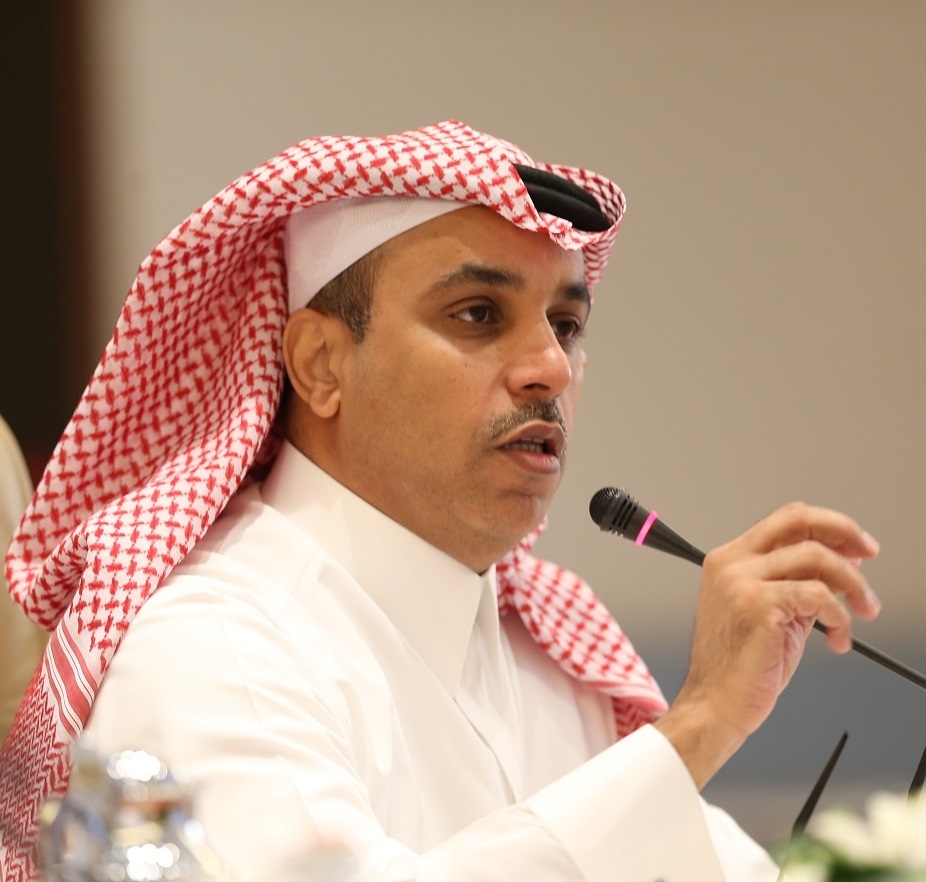
الهيئة العامة للإحصاء تبدأ العمل بالهيكلة الجديدة
New (Statistical, Creative, and Awareness) Departments to Cope with the Requirements of the New Saudi Vision and National Transformation
GaStat Starts Working with the New Structure
The General Authority for Statistics starts working with the new organizational structure. A general administration for natural resources and knowledge statistics has been created. It works beside the general administration of economic statistics, the general administration of social statistics, field statistics departments, methodologies departments, creativity departments, and awareness departments.
GaStat president, Dr. Fahad bin Sulaiman Al-Tukhaifi said that working with this new organizational structure is a response to the 2030 Saudi vision and 2020 national transformation program. The next phase needs integrated efforts from the statistical sector, so the sector must work in a distinct way as it is the only official sector that is responsible for the production of data, information, and statistics, which reflect the developments in Saudi Arabia.
Dr. Fahad clarified that the new structure, which has been authorized since the first day of this Muhharam, is a way that guarantees achieving the authority's strategic goals that are represented in enhancing the efficiency and quality of statistical services and products. Moreover, it makes these services more comprehensive and beneficial. It also helps to raise the satisfaction level of all clients and beneficiaries, gives the authority a positive reputation in the society, promotes the statistical sector level, and builds a strong authority.
Al-Tukhaifi added that this new structure is based on the statistical development' national strategy aspects, covering five aspects that guarantee the efficiency of the statistical sector in Saudi Arabia. The first aspect is using the statistical data and information, which aims at improving the use of statistical data and information in Saudi Arabia. This would fulfill all the users' needs by providing easy and on time statistical data and information. There is also the aspect of statistical data and information production, which aims at enhancing the field operations such as censuses, surveys, and researches. Furthermore, it enhances using the most recent standards and classifications in collecting, analyzing, and publishing data. The third aspect is the recent technologies. It aims at using the most recent technologies in all the phases of the statistical and administrative work. It provides a high quality IT infrastructure. The fourth aspect is the communication and awareness, which aims at enhancing the statistical knowledge in society through education and awareness. It introduces those who work in the statistical sector with the concept of communication. The fifth aspect is about governance. Through this aspect, the authority is trying to set the principals that govern the statistical sector. This enhance the idea of "results based management" . It continuously develops the human resources and tries to recruit people with high capabilities.
As for the main components of the authority new structure, Dr.Fahad stated that the organizational structure has been made by a teamwork from the authority and some experts outside the authority. This structure was made to develop and improve the statistical work. It also positively collaborate in activating the strategic transformation through which the Saudi statistical work is going. It enhances the role of the entity that supervises and organizes the statistical work by transforming it into an independent authority that has a featured personality and administrative and financial independence. The teamwork worked on determining the tasks, duties, and regulations according to certified instructions that guarantee founding an effective and comprehensive statistical organization. This new organization focused more on the clients and raising the products quality, considering them the main dimensions of work. The new statistical organization has been built in a way that prevent duality in work and responsibilities. It also intends to make the organizational structure compatible with the authority’s strategy by collecting the harmonized activities in one sectors and administrative units to implement unified tasks. In this structure, Many administrations and departments have been founded to achieve the strategic goals.
Regarding the main components of the new organizational structure, the authority president revealed that the statistical and administrative work has been distributed among three main sectors headed by the vice presidents. These sectors include the statistical works sector, which contains general administrations of economic statistics, social statistics, and natural resources and knowledge statistics (new one). In addition to the independency of the statistical field works with a general administration of operations. There is also an administration specialized in methodologies.
As for the second sector, the statistical creativity and customer service sector, it is a totally new sector. However, the third sector represents IT and supporting services, as they are the main infrastructure of the authority’s statistical and administrative work. Moreover, the new structure includes a general administration of media and statistical awareness, which manages all the internal and external activities aiming at raising statistical awareness. It also includes a general administration of projects and strategic planning which implements and prepares the authority’s strategies and plans. Furthermore, there is a general administration of support and institutional excellence that manage, prepare, and update all the policies, operations, and procedures. The later also supervises the programs of total quality department and knowledge department.
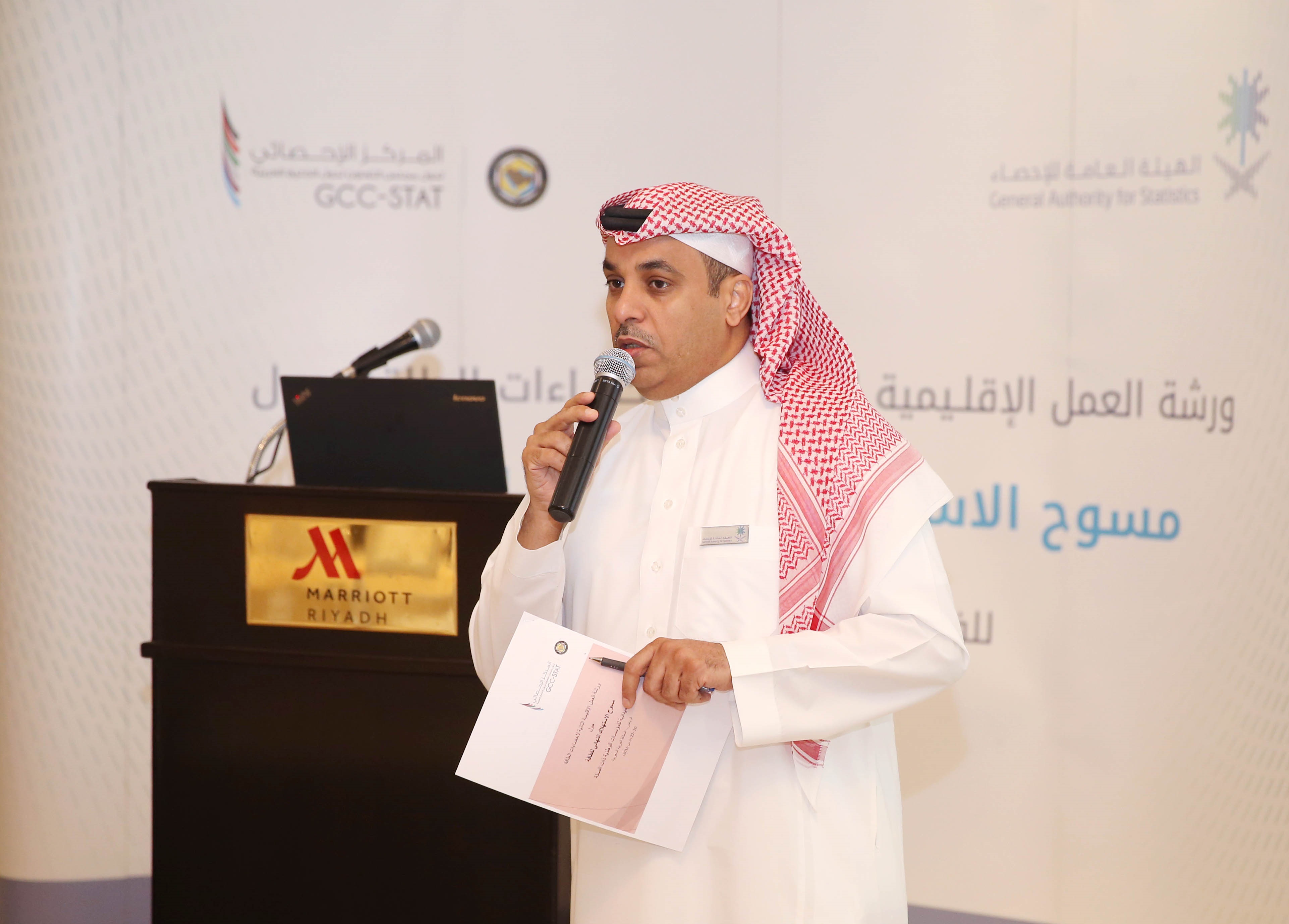
د. التخيفي: نهدف إلى توحيد معايير منتجي البيانات لخدمة مواطني " الخليج "
GCC "Energy Statistics" in Riyadh
Dr. Altekhaifi: We aim to unify Data producers' Standards to Serve "GCC" Citizens
Media center- Riyadh
The Chairman of the GCC Statistical center, the Chairman of the General Authority for Statistics in the Kingdom of Saudi Arabia, Dr. Fahad Sulaiman Altekhaifi expressed his thanks and gratitude towards the leaders of the GCC countries for supporting all programs and activities of the "GCC Statistical centre", as a result of their role in supporting all decisions related to the development of GCC nations. Dr. Altekhaifi asserted that the results of the Energy Statistics' Second Regional workshop about the final consumption of energy surveys held in Riyadh city meet the needs of the national and regional policy makers of the energy sector. It will also support everything that would develop the energy sector in GCC countries. Dr. Altekhaifi also added that through this workshop, the GCC statistical centre seeks to strengthen the cooperation between energy statistics producers, and unify the efforts in the used technical standards. In addition, it seeks to implement International standards by all data producers in member countries.
Dr. Altekhaifi revealed that the most important role of data producers in this meeting is to reinforce the understanding of the international standards related to energy statistics in the statistics system. In addition, it aims to explain the links between energy data groups and discuss the user's needs by enhancing the data and its publishing. Moreover, it aims to unify the efforts to raise the awareness about the methodologies needed in preparing energy statistic in the region. Furthermore, it aims to deepen the participants' understanding of international standards that support energy statistics. Also it clarifies the importance of the final consumption surveys' system.
In this workshop the participants reviews the national experiences of the member countries and the importance of the energy final consumption surveys. In addition, the participants visits several energy sector related entities in the kingdom of Saudi Arabia. This workshop continues until 22 March, 2016.
It is worth mentioning that The GCC Statistical Centre was established in June 2011 to provide a common official pool of statistics and data for the member states of the GCC. It was also established to support the statistical work of national statistical centers and planning entities in GCC countries.. The Charter was officially endorsed in December 2012 by the GCC Supreme Council (comprised of heads of member states: United Arab Emirates, Kingdom of Bahrain, Kingdom of Saudi Arabia, Sultanate of Oman, State of Qatar and State of Kuwait).
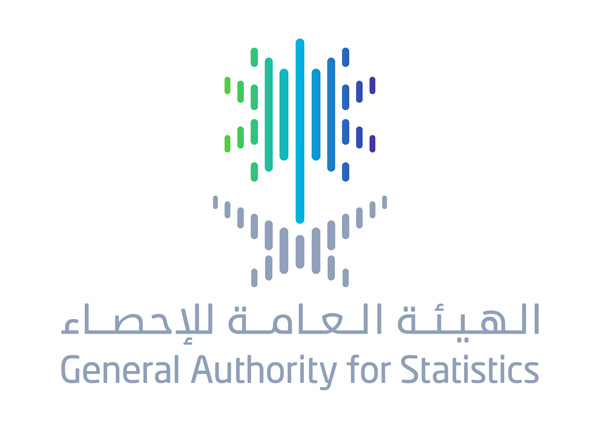
" الإحصاء " : دقَّة المعلومات التي يُقدِمُها المواطن ركيزة أساسية لقرارات ومشاريع حكومية
Updating the general framework of population and housing paves the way for a new labor force survey
"statistics" the accurate information provided by citizens is essential for governmental resolutions and projects
Media center- Riyadh
Supporting the resolutions of nationalization and reduction of "unemployment", the General Authority for Statistics ( GaStat ) stresses the importance of information accuracy provided by citizens in the activities of labor force surveys as these information are essential for the development resolutions and can determine many national programs and projects.
During his participation in the first Saudi conference for job creation held in Riyadh, GaStat chairman, dr. Fahad Altukhaifi stated that the citizen is considered the base for development building , that is through the information that he/she provides during the process of conducting surveys done by GaStat crew.
As for the survey of labor force, dr. Fahad confirmed that it is one of the most important household surveys conducted by GaStat . it provides fundamental data about the labor force and its characteristics, which helps in setting the plans to develop the labor market in Saudi Arabia, analyzing and evaluating the economic policies, and helping the decision makers in setting the labor market policies with all the related issues such as unemployment and training. The labor force survey results are very important too as they collaborate in building a data base for the Saudi labor market in order to cope with the interest and anticipations of the labor force statistics nationally, regionally, and internationally. The results also support all tendencies and efforts exerted by the public and private sectors in the process of nationalization. Moreover, they give an opportunity to collaborate in building a base for these information that can be beneficial in preparing and planning the future economic and social development programs. The authority conducts this survey every six months , it intends to conduct it every three months in 2016 according to the latest international standards and methodologies.
The authority chairman added that providing detailed data about the national and non-national labor force ,classified by their economic, social, and demographic characteristics, is one of the main objectives of the survey, in addition to its role in measuring the averages of economic collaboration, economic support, and employment and unemployment by many variables. It should also provide data about some training programs for job seekers, and be familiar with the vocational structure and the economic activity of employed people by a number of variables and the average of their salaries.
Dr. Altukhaifi thanked all governmental entities who work with GaStat . he assured that the authority is working with all governmental entities which are related to the Saudi labor market ( ministry of labor, human resources development fund, general organization for social insurance, ministry of civil services, and the national information center in the ministry of interior) in order to develop the survey on one hand and benefit from its results on the other hand. The authority is working with them also to unify the efforts so that they can get accurate data of the most important indicators in the Saudi labor market.
It is worth mentioning that the labor force survey results depend on the data and information of (33.500) households, distributed among all Saudi administrative regions, as a sample that represents the society. The households are chosen according to international and scientific fundamentals applicable in the population and housing censuses all over the world . GaStat has started preparing for the next survey after updating the general framework of population and housing which depends on the 1431 framework as it is considered the main source from which samples are collected to conduct future researches.
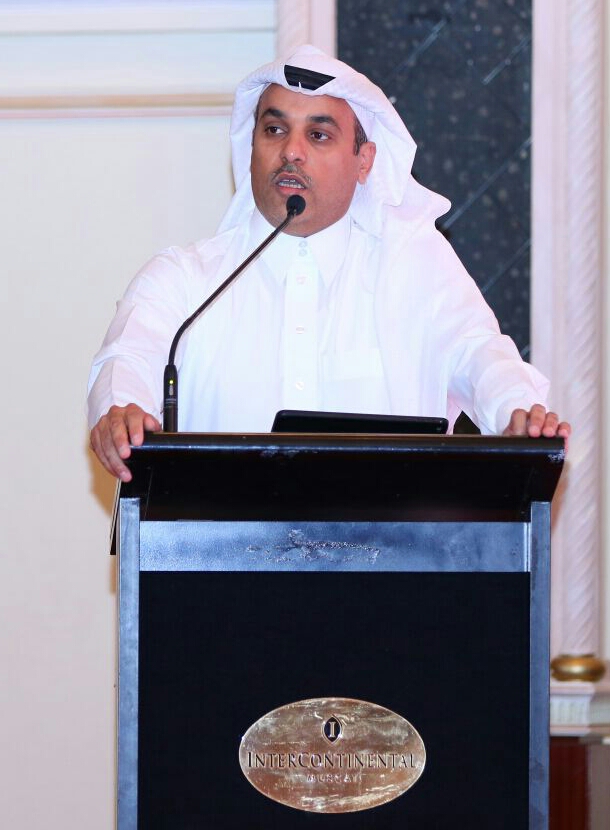
د. التخيفي : الإحصاء يدعم قرارات من شأنها الحد من ظاهرة ارتفاع الأسعار
The GCC Statistical Centre Launches the General Consumer Prices Index
In pursuit of the Gulf Cooperation Council (GCC) countries to find a number of coordinating and corrective procedural policies that will help in reducing the phenomenon of rising prices in the GCC countries, the GCC Statistical Centre launched the project of "GCC Consumer prices index", and "the statistical centre data portal" in Muscat, Oman, under the auspices of His Excellency Sheikh Khalid Almarhoon, the Minister of Civil services in Oman.
The chairman of the General Authority for statistics in Saudi Arabia, the chairman of the GCC Statistical center in its current cycle, Dr. Fahad bin Sulaiman Altekhaifi, asserted that the index number is considered to be an important tool to support decision makers in all private and public sector entities in GCC countries to prepare coordinating and corrective procedural policies that contributes in reducing the phenomenon of rising prices in the GCC countries. It is also considered to be an economic phenomenon with social dimensions. In addition, the new indicator will provide a unified prices statics data base with all its details, which will help the beneficiaries to use the information in various related fields.
Talking about the statistical centre data portal, Dr. Altekhaifi added that the goal of inaugurating the portal is to enable the observation of statistical data and documenting achieved advancements in the indicators of the GCC countries in different economic, social, and energy sectors. In addition, its goal is to provide information services that contributes in raising statistical awareness.
On the other hand, in the speech of Dr. Altekhaifi, he asserted on developing and supporting the statistical and institutional abilities, to keep pace with the statistical requirements on the GCC countries' level and internationally. He also asserted that this is one of the most important common goals on the strategic level of the GCC countries. He also added that the authorities and Gulf statistical centers are seeking to continuously reinforce and enhance the quality and quantity of statistical services, and develop, expand and market the statistical publishing. Also, it seeks to show the GCC countries' region as a unified social and economic region through unifying the national statistical strategies in the GCC countries with the combined statistical programs needs according to the best international practices. Altekhaifi also explained that everyone is working on building statistical culture and raising statistical awareness, in addition to reinforcing the actual and correct use of statistical data and information in decision making and policy making in GCC countries.
Altekhaifi also revealed about ten of the most important projects that are considered to be the top statistical priority determined by the GCC statistical centre, which are: the national accounts, environment and energy, financial executive statistics, balance of payments, development, progress and sustainability indicators, short term prices and indicators, unified registered population census (year of 2020), foreign trade, administrative data, job market, and the statistical standards, categories, methodologies, and data quality.
It is worth mentioning that the GCC statistical centre was established in September 2011, and its organization was approved in 2012 by the supreme council of the GCC to be the official source of statistical information and data related to GCC countries. It was also established to reinforce statistical and informational work of the national statistical centers and planning in GCC.
وزير الاقتصاد يُدشن عمل الهيئة العامة للإحصاء وبوابتها الإلكترونية...هيئة الإحصاء توقع 4 اتفاقيات مع جهات حكومية وخاصة
Minister of economy launches the general authority for statistics and its electronic portal
The authority of statistics signs 4 agreements with private and public sectors
Media center- Riyadh
Minister of economy and planning, chairman of the general authority for statistics, Eng. Adel bin Mohammed Faqeeh, launched the first day of working in the statistical field with a new structure and identity. This was an implementation of the supreme decree issued on 26-12-1536 H which states transforming the central department of statistics to be a general authority called ( the general authority for statistics). The authority is financially and administratively independent. In his speech that was declared in the launching event which was held in Marriot hotel, the minister expressed his gratitude and thanks to the custodian of the two holly mosques, king Salman bin Abdulaziz Alsaud, may God protect him, for his approval to transform the central department of statistics to be an independent authority. He confirmed that the work will start officially in the general authority for statistics as a result of many supreme directives, orders, and resolutions that support and enhance a lot of governmental sectors by transforming them into independent authorities that provide services compatible with the rapid changes and developments.
On his part, the authority's general director, dr. Fahad bin Sulaiman Altukhaifi, in his name and on behalf of all the staff of the central department of statistics , and all those who work in the statistical sector , he expressed his gratitude and thanks to the custodian of the two holy mosques for his supreme approval to transform the central department of statistics to a general authority. Dr.Fahad said that this transformation process has been done through six fundamental tracks which can be briefed in a working strategy that is all about the authority’s clients and partners to fulfill the actual need of statistical products, then developing these products and services and improving statistical and data methodologies and procedures. In addition, it focuses on upgrading the level of information technologies and digital infrastructure in order to give the products the ability to start from a very tough base that can cope with all technological changes. It also concentrate on raising awareness and literacy in the statistical field, and finally structuring the authority’s different tasks and departments. He assured that the general authority for statistics’ role has become more important as long as there are national transformation projects as it is very crucial to provide accurate statistical data and effective indicators besides developing the measurement tools.
On the first working day and after the transformation process, the authority’s general director has announced that the first of Muharram of the next year will be the day in which the information bank will be issued. This bank is one of the statistical development national strategy’ aspects, which aim to organize statistical data and information in Saudi Arabia, to guarantee providing the governmental sectors and individuals with statistical information and indicators through an easy and accurate technique. This is to support the development decisions via collaborative system, which starts with electronic linking between all data resources in many related sectors. Furthermore, minister of economy and planning Eng. Adel bin Mohammed Faqeeh has launched the electronic portal of the general authority for statistics. In this portal, the users can get all the needed information in very easy and direct ways through many windows and according to the international statistical and technical standards. On the first working day, four agreements have been signed with different private and public sectors. The authority has signed two agreements with the national information center in the interior ministry and e-government program (yesser). These agreements have been signed to develop the techniques of collecting, exchanging, and integrating data. The third agreement has been signed with the national center for communication, aiming to develop the mechanisms of communication with disabled people. It also aims to provide statistical content in sign language. On the other hand, the central department of statistics and information ex-directors and retired employees were honored.
After the launching event, the authority held an introducing workshop with many partners from both the private and public sectors. This workshop aimed to introduce the authority and its roles. The participants watched a detailed presentation about the products and services in addition to the interactive statistics window and a brief of the statistical awareness. The minister of economy and planning revealed that the statistical sector partnership with the private and public sectors will open many opportunities for the statistical sector to be constantly developed and improved in order to be able to effectively collaborate in supporting any developmental decision taken by any private or public sector in all fields of national development. It is worth mentioning that the ministers’ council resolution issued on 13/1/1437 H included the approval of general authority for statistics structure, and made it the only authorized entity that technically and structurally supervise the statistics sector. It also made it the only responsible authority for creating thorough national statistical databases in different fields. Moreover, it made it the only responsible entity for managing the authority affairs and creating its own board of directors

ستة مسارات عملتْ عليها "الإحصاء" خلال 90 يوم.. أربعة أيام ويبدأ القطاع الإحصائي نقلته الجديدة
"Statistics" worked on six tracks in 90 days
Four Days and the Statistical Sector will Start a New Era
Media Center
The Saudi statistical data and information sector is starting a new era after declaring the changing of the central department of statistics to be an authority named" the general authority for statistics". This transforming will start officially on Wednesday 1st of jamad first.
Director of media and statistical awareness department and the spokesman of the authority, Taiseer Almufarij states that working under the umbrella of the general authority for statistics is considered an implementation of the supreme decree number ( 64283) in 26/12/1436 H which declares transforming the central department of statistics to be a general authority called the general authority for statistics. This authority is financially and administratively independent. The supreme decree gave ninety days for the transforming process. The countdown is about to finish now and this Wednesday will be the first official day to work under the new name. Almufarij confirmed that this transforming is not only about changing the name or identity, but changing content, techniques, and mechanisms as the statistical sector must cope with all the rapid changes around it otherwise it cannot go farther. With the increase of commercial transactions, international investments, social and economic changes, mass data revolution , and the development of digital media and portable technologies, it has been a need for the statistical work to go through a vital transforming process in order to satisfy the clients and fulfill their needs which require the authority to establish a mutual partnerships, estimate their current and future needs, unify the information sources, facilitate access to this sources, and provide more advanced statistical products.
Almufarij said that the general authority for statistics is undergoing a transforming plan that has six major tracks: concentration on the client strategy, developing products and services, enhancing methodologies and procedures, upgrading information technologies and infrastructure, statistical literacy and building competences, and structuring all the authority's different tasks and departments in order to keep developing the authority and making it a distinct institution.
It is worth mentioning that the Saudi statistical work has started in a very early era of the Saudi development history. It has started in 1349H /1930 AD and continued for thirty years till the issuance of the general statistics system in royal decree number (23) which made the statistical work a sector that refers technically and administratively back to an official system that cooperated in organizing the statistical sector by setting the rules of relation between the central department as it is the only central department for statistics and the other sectors. This system aimed to activate the statistical work and make it more comprehensive, and raise statistical awareness. During the last fifty eight years, the department worked on many surveys, censuses, and indicators in many different fields in Saudi Arabia.

د. التخيفي : كلمة الملك سلمان رسمتْ خطوط الإدارة الجديدة للتنمية

مدير المصلحة: تحويل الاحصاءات الى هيئة يصنع شراكات فاعلة
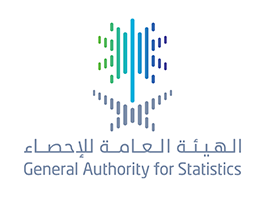
الهيئة العامة للإحصاء : ارتفاع الصادرات وانخفاض الواردات السلعية للمملكة العربية السعودية في الربع الأول 2017
GaStat: An Increase in Exports and a Decrease in Merchandise Imports of Saudi Arabia (1st quarter-2017)
The value of merchandise exports of Saudi Arabia during the first quarter of 2017 amounted to (206984) million riyals compared to (140186) million riyals for the same quarter last year, with an increase of (66799) million riyals (47.7%). While non-oil exports amounted to (44849) million riyals during the first quarter of 2017 compared to (43029) million riyals for the same period last year, with an increase of (1820) million riyals (4.2%). The value of Saudi Arabia's imports during the first quarter decreased by (12.3%) to reach (125558) million riyals with a decrease of (17542) million riyals compared to same quarter last year which recorded (143100) million riyals.
According to the quarterly report issued by GaStat for the first quarter of 2017, the value of Saudi merchandise exports recorded an increase of (5.2%) compared to the last quarter (4th quarter 2016) which recorded (196842) million riyals. While non-oil exports recorded a decrease of (4.5%)compared to the last quarter (4th quarter 2016) which recorded (46964) million riyals. The Saudi imports recorded a decrease of (0,05%) compared to the last quarter which recorded (125616) million riyals. The ratio of non-oil exports to imports reached (35.7%) in the first quarter of 2017 compared to (30.1%) for the same quarter last year, but this percentage was lower than the previous quarter (fourth quarter 2016), which recorded (37.4%).
The report shows that 20.4% of the imports were capital goods, 39.3% intermediate goods and 40.3% imports were goods for final consumption.
The increase in the value of non-oil exports in the first quarter of 2017 compared to the same quarter of last year was the result of the rise of the most important sections of merchandises exported, mainly plastics, rubber and their products, which rose by (9.8%) to the value of (14570) million riyals.
The products of chemical industries and related industries increased to (13355) million riyals compared to (11361) million riyals in the first quarter of 2016, which means an increase of (1993) million riyals (17.5%). Base metals and its products increased to (3703) million riyals Compared to (3636) million riyals in the first quarter of 2016, which means an increase of (66) million riyals (1.8%). The exports of Saudi Arabia in the transport equipment and its parts, machinery, and electrical appliances and equipment section reached (6204) million riyals which form (13.8%) of the Saudi non-oil exports in this period.
Regarding imports, the machinery, electrical appliances and equipment and thereof decreased by (19.3%) to reach (30191) million riyals in the first quarter of 2017 compared to (37397) million riyals in the first quarter of 2016. The imports of transportation equipment and thereof decreased to (20529) million riyals compared to (25377) million riyals (19.1%). While imports of chemical products and related industries decreased by (4.7%) to record (12638) million riyals in the first quarter of 2017 compared to (13268) million riyals for the same period last year.
The report pointed out that the total volume of non-oil exported merchandise increased to (13248) thousand tons in the first quarter of 2017 compared to (13103) thousand tons in the first quarter of 2016, which means an increase of 1.1%. The volume of imports in the first quarter of 2017 also decreased to (17130) thousand tons compared to (20561) thousand tons for the same quarter of last year with a decrease of (16.7%).
On the geographical distribution of Saudi Arabia's exports of non-oil merchandise, the report pointed out that exports to Asian countries, excluding Arab and Islamic countries, are at the top of the groups that have been exported to, recording a rise of (32.1%) to register (14246) in the first quarter of 2017 compared to (10781) million riyals in the first quarter 2016.
Exports to the GCC countries decreased by (4.9%) to reach (11934) million riyals, while the rest of the groups decreased to (5.3%) to register (18669) million riyals.
UAE is the top country for exports in the first quarter of 2017:
The United Arab Emirates, China, India, Singapore and Kuwait are the top countries for exports, as their exports formed (41.7%) of the total non-oil exports compared to (36.6%) in the first quarter of 2016.
China is the top country for imports in the first quarter of 2017:
The United States of America, China, Germany, the United Arab Emirates and Japan are the top countries of imports, as their merchandise imports formed (45.9%) compared to (46%) in the first quarter of 2016.
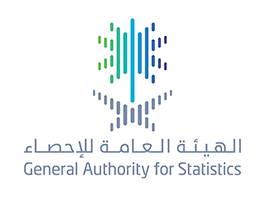
الهيئة العامة للإحصاء تصدر مؤشر الرقم القياسي للعقارات للربع الثاني – 2017م
Based on record data from the Ministry of Justice
GaStat Issued the Real Estate Price Index for the 2nd Quarter- 2017
On Monday 1 Dhu al- Qa’dah, 1438H (July 24, 2017), the General Authority for Statistics (GaStat) issued the Real Estate Price Index in Saudi Arabia, which is based on record data available at the Ministry of Justice about real estate transactions. GaStat described the Real Estate Price Index as an important tool to support stakeholders in making economic and statistical decisions regarding the movements of real estate prices and future forecasts during different periods of time. The index includes three main sectors consisting of several types of real estate: Residential sector consisting of the following types (land, Apartment and house), commercial sector consisting of (land, building, showroom/ store or commercial centre), agricultural sector consisting of one type which is agricultural land.
The Real Estate Price Index showed a decline in real estate prices for the second quarter of 2017, which reached 0.6% compared to the previous quarter (1st quarter 20170) . the index also recorded a decline of 8.6% in the second quarter of 2017 compared to the same quarter last year (2nd quarter 2016).
The report, which was published today, attributed the decline in Real Estate Price Index for the 2nd quarter of 2017 compared to the previous quarter (1st quarter 2017) to the decline witnessed in two of the main sectors comprising the index: the commercial sector 2.2% and the agricultural sector 0.2%, while The housing sector rose 0.2%.
The decline in the Real Estate Price index for the second quarter of 2017 compared to the previous year (second quarter 2016) is the result of the decline in all the main sectors comprising the index: the commercial sector 10.9%, the residential sector 7.9%, the agricultural sector 1.0% .
As part of its duties as an official reference for statistics in Saudi Arabia and as a supervisor and organizer of the statistical sector, the General Authority for Statistics has taken care to monitor the movements of the prices of the constituent units of the real estate sector and monitor the value of their transactions in various regions of the Kingdom and follow the changes that occur from time to time through the statistical product “Real Estate Price Index” which is prepared based on data provided by the Ministry of Justice in this field, within the framework of integration and cooperation between the various governmental bodies aimed at advancing sustainable development in the Kingdom.
This product aims at finding unique real estate indices that measure the performance of real estate market in the Kingdom and fill the data gap in this sector. It is an important tool to support economic decision makers. Its data benefit individuals interested in the economic and statistical analysis of real estate movements and future forecast during different periods of time.
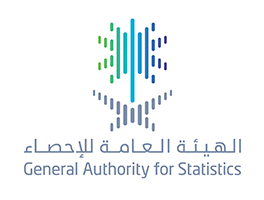
توصيات المنتدى الإحصائي الخليجي الأول
First: Recommendations to improve efficiency of statistical entities:
Second: Recommendations to improve efficiency of statistical products:
Third: Recommendations to follow up indicators of sustainable development:
Fourth: Recommendations to activate statistics technology use:
Fifth: Recommendations to raise statistical awareness:
Sixth: Recommendations to improve private sector efficiency:
Seventh: Recommendation to develop inter-Gulf statistical work:
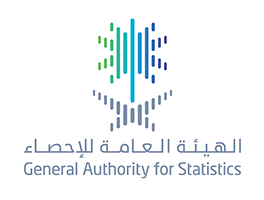
الهيئة العامة للإحصاء تصدر الكتاب الإحصائي السنوي 2016
Including data of more than 57 entities
GASTAT issues the 2016 annual book
The general Authority for Statistics GASTAT issued its annual statistical book (52) of the year 1437/1438H (2016). This book is considered one of the most important statistical products that GASTAT issues to register and document all statistical data and information and present the public and private sectors’ activities. Moreover, it reflects the growth and development rates in demographic, social, and economic fields. The statistical book, which has more than 460 pages, includes the most important data and information of many developmental sectors. Furthermore, it includes the results of the statistical works conducted by GASTAT over one year, in addition to what GASTAT receives from the governmental statistical departments. The data and information have been distributed among 15 chapters. the book also specified 289 tables that contain data and information of more than 57 government entities.
The statistical book data includes statistics of population, education and training, health. Social services, social insurance, transportation and telecommunication, water and energy, labour market, prices and indices, financial and monetary affairs, national accounts, industry, agriculture and hunting, local and foreign trade, and cooperation council. In addition, it includes statistics about natural conditions, thermometers readings, some natural phenomena such as dust, rainstorms, fog, rain quantity, humidity, atmospheric pressure, and wind speed.
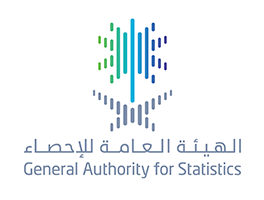
المملكة تشارك في أعمال الدورة ( 48 ) للجنة الإحصائية للأمم المتحدة
To develop the statistical sector and follow up the sustainable development goals
Saudi Arabia participates in the (48) round of the UN statistical commission
Saudi Arabia participates in the 48th round of the UN statistical commission which is currently held in the UN headquarter in New York. The commission works will continue till Saturday 10th of March 2017. The Saudi delegation is headed by Dr. Fahad bin Sulaiman Altekhaifi. Dr. Fahad said that the participation represents part of the general authority for statistics strategy in establishing international collaborations and benefiting from the best statistical practices, so that they can be reflected on the development of the statistical sector in Saudi Arabia. He added, with this participation, Saudi Arabia aims at following up all the developments regarding the sustainable development agenda and the measurement indicators that are approved by the UN statistical commission to measure the progress in achieving economic, social, and environmental goals. In addition to the effective participation that reflects the important role of Saudi Arabia in the international statistics map. The Saudi delegation will also discuss the proposed mechanisms to develop the national statistical systems and methodologies, prepare statistical policies that affect the development process to support decision and policy makers, in addition to the exchange of experiences provided by statistical, developmental, and economic international organization.
On the other hand, Dr. Fahad clarified that this round will discuss many essential topics related to the role of statistical data in the development process, and developing its methodologies and data sources and the way they are published to be available for users on the proper time. Moreover, the round will discuss the agenda of official statistical systems transformation to enable countries to update the statistical process in order to support sustainable development agenda. GaStat will participate in discussing all issues related to prices, national accounts system, economic-environmental accounting, statistical classifications, international trade, weather statistics, disability statistics, IT and telecommunication statistics, big data as a new source of official statistics, and other topics related to quality assurance, official statistics fundamentals, the preparations for the coming HH surveys, and many other topics.
It is worth mentioning that Saudi Arabia has been selected with other (11) countries from all over the world to be a board-member in the international comparison program (ICP) in the United Nations (round 2017-2019). It has been nominated by the UN statistical commission and the data development group in the world bank to represent West Asia countries. Saudi Arabia has been selected for the positive role of the general authority for statistics (GaStat) in the different statistical programs organized by the united nations. The ICP structure includes: UN statistical commission, board of directors (with GaStat membership), and the mutual team works from different agencies and coordination committees and technical consultations. In addition to the international implementing entity (the world bank), the regional offices, Eurostat, OECD, and the national offices and organizations.
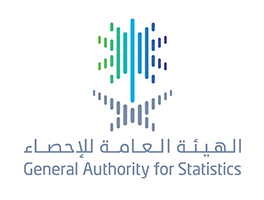
إطلاق مسابقة البحث الإحصائي للشباب.. وجوائز مالية بانتظار المراكز الثلاثة الأولى
Within the activities of the first Gulf Statistical Forum in March
GCC-STAT is launching the Statistical research competition for young statisticians… Cash prizes for the first three winners
The Statistical Centre for the Cooperation Council for the Arab Countries of the Gulf (GCC-Stat) has launched the statistical research competition for young statisticians 2017 which will be held within the activities of the first Gulf Statistical Forum that will take place from March 20th till March 22nd, 2017 in Riyadh city.
The competition aims at reinforce statistical research value, raise the spirit of competition among young statisticians in the GCC countries, discover the statistical abilities and talents of Gulf youth, produce new statistical subjects and methods that keep up with the needs of Gulf societies.
The competition targets young statisticians working in the statistical sector who are GCC citizens, whether working in national statistical centers or in statistical official government institutions. The competition also targets students (GCC citizens) from different Academic institutions such as colleges and universities (public and private).
The statistical center has set two subjects to chose from, the first addresses a new methodology or new statistical methods in official statistics, this includes technical applications that helps in statistical work (such as new methods to collect and disseminate data), while the second subject revolves around the extent of official statistics' contribution in achieving development progress in one of the countries in the region.
To be eligible, the submitter must be a citizen of GCC countries under the age of 35 on February 20, 2017. The submitter must also be working in government official statistical sectors in GCC, including national statistical centers and other official bodies producing statistics, or a student in public or private educational institutions in the GCC countries such as colleges or universities.
The applicant has the right to form his own team , each team is a maximum of three members, the research paper must be new and prepared specifically for the forum competition, and has not been previously presented in another competition or forum or has been published anywhere. It also must be within the subject of the competition and has the specific technical requirements. The applicant must attach a copy of his/her passport and ID.
February 20, 2017 is the last day for submission, and the first three winners will be awarded with cash prizes. Applicants can send their entries to the email: Competition@gccstat.org .
The first statistical forum is held by the General Authority for Statistics and The Statistical Centre for the Cooperation Council for the Arab Countries of the Gulf, under the title "Enhancing the Statistical Partnership to Support Economic Policies and Sustainable Development in the GCC Region", under the high patronage of the Custodian of the Two Holy Mosques, King Salman bin Abdulaziz Al Saud – May God Protect him.
The forum will focus on main aspects; requesting statistical data and information from national growth tracks, sustainable development agenda and emerging international economic issues, negotiating the provision of statistical products and services to support the national growth tracks and sustainable development agenda in GCC countries, and discussing the enhancement of statistical collaborations between data users and producers to support the economic policies and sustainable development agenda in GCC countries.
GCC Statisical Forum Click here
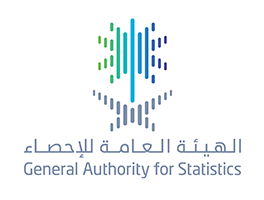
الهيئة العامة للإحصاء: الرقم القياسي لأسعار الجملة ينخفض بنسبة 0.7%
7 sections has decreased, and an increase in the manufactured commodities and fats & oils
Gastat: the Wholesale Prices Index decreases by 0.7%
On Tuesday 21 Rabi'e Al-awwal, 1438 corresponding to December 19 2016, GaStat issued its monthly indicator of the Saudi Wholesale Prices Index of November. It is now published on its official website www.stats.gov.sa. The indicator recorded (160.7) with 0.7% decrease in November 2016, compared to last month (October) in which it recorded (161.8).
The indicator includes ten main sections; Food and living animals section, beverages and tobacco section, raw materials except fuel, mineral fuel and related products section, Fats and oils section, chemical materials and related products, manufactured commodities classified by material section, transportation equipment and machines section, diverse manufactured commodities section, and other commodities section.
The report attributed the increase of the wholesale prices index in November to the decrease of the 6 main sections that constitute this indicator: other commodities by (3.2%), Food and living animals section by (1.8%), transportation equipment and machines section by (0.8%), chemical materials and related products by (0.4%), miscellaneous manufactured commodities section by (0.3%), beverages and tobacco section by (0.1%), raw materials except fuel by (0.1%),. On the other hand, 2 of the main sections have increased: manufactured commodities classified by material section by (0.2%), fats and oils section by (0.1%), whereas the mineral fuel and related products section remained the same without any changes.
The authority indicated that the Saudi wholesale index measures the average of change in the prices of commodities and services that are sold in the primary markets. What matters here is the price change only. Therefore, the changes that result from the differences in quality, quantity, shipping method, or any other influencing factor in order to get the net price are excluded. This index is provided to everyone, and conducted all over Saudi Arabia.
It is worth mentioning that the wholesale price index is used to record any change in the prices of local or imported commodities. In addition, it monitors the price trends and the status of markets and costs of living. Furthermore, it is used in preparing the national accounts by protecting the income and national aggregates from the influence of price change.
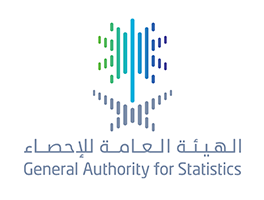
الهيئة العامة للإحصاء: انخفاض مؤشر الرقم القياسي لتكلفة المعيشة لشهر نوفمبر (0.2%)
(6) sections decreased, and (3) rose
"GaStat" : The indicator of the Cost of Living Index decreases in November by (0.2%)
On Monday 20th of Rabi'e Al-awal , 1438 corresponding to December 19, 2016 the General Authority for Statistics (GaStat) issued the monthly indicator of Saudi cost of living index for the month of November. It is now published on its website www.stats.gov.sa . The index recorded a decrease of (0.2%) compared to the previous month (October 2016).
The monthly report indicates that the Saudi cost of living index has reached (137.5) in November 2016 compared to (137.8) in last October , recording a decrease of (0.2%). The report attributed the monthly decrease to the decline of the six main sections that constitute this indicator: food and beverages by (0.6%), clothes and shoes section by (0.6%), furniture, appliances, and maintenance by (0.5%), culture and recreation by (0.4%), health by (0.2%), finally, communication section by (0.2%).
On the other hand, 3 of the main sections have witnessed an increase, which are: the transportation section by (0.2%), restaurants and hotels by (0.1%), and the commodities and commodities and miscellaneous services by (0.1%). Whereas, the sections of tobacco, housing, water, electricity, gas, and other types of fuels , and education remained the same with no any relative changes to mention.
The cost of living general index issued monthly by GaStat aims at providing data about the prices of commodities and services that are in the consumer basket. It also aims at providing data about the cost of living indices within a time series. (The consumer basket) refers to the actual group of commodities and services that are recorded during the household expenditure and income survey. The relative distribution of the commodities and services consumption inside the consumer basket is extracted to make it the base stone in the process of indices calculation. The cost of living indices are used to measure any change in the prices of commodities and services that are purchased by consumer. Moreover, it is used as an accurate indicator that measures the economic inflation and recession. It is also used in statistical and economic analyses that are associated with prices movement and anticipations in different times. Data are collected by conducting interviews. The sources addresses are clarified to the interviewers to facilitate their task. The sources distribution in one city must cover all available commodities and services with all levels.
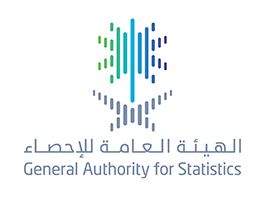
الهيئة العامة للإحصاء: 1125 فريق رياضي يجري 4220 مباراة في عام 2015
Issuing an indicator about the numbers of sports federations, clubs, stadiums, matches, and sports teams
GaStat: 1125 teams played 4220 matches in 2015
On Monday, 6 /Rabe'a First/ 1438 corresponding 5/ November /2016, GaStat issued an indicator about the numbers of sports federations, clubs, stadiums, matches, and sports teams (2011-2015) classified according to Saudi Arabia's administrative regions and their sports federations, ordinary clubs, and disabled and deaf people clubs. The indicator clarifies the number of matches of all individual and group games, in addition to the number of stadiums for each kind of games including closed area stadiums. It also clarifies the number of sports teams.
The indicators states that the number of sports federations in Saudi Arabia has increases from 30 federations to 35 federations in the period (2011-2015). However, the number of clubs including disabled people clubs reached 188 clubs with 1125 sports teams. 4220 matches have been played in 387 closed and open stadiums.
Riyadh region registered the highest numbers in the indicator results with 35 sports federations, 47 clubs, 722 individual and group matches, 99 stadiums for all kinds of games, and 285 teams in 2015.
In its published indicator, GaStat said that sports statistics are one of the most important cultural indicators locally, regionally, and internationally. GaStat started collecting sports data from their official reference. Furthermore, it revealed that the indicator presents all changes in the numbers of sports clubs ,federations, and teams, in addition to the developments in stadiums during the last five years.
It is worth mentioning that this indicator was launched as part of the 45 statistical products announced lately by GaStat. Their launching constitute the first stage of the new products which include economic, social, demographic, Omrah, and labor market statistics. In addition to other statistics related to energy, knowledge, environment, culture, sport, entertainment, security, and safety.
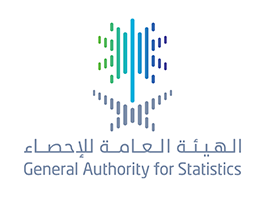
الهيئة العامة للإحصاء : 43.5 مليار ريال قيمة الصادرات النفطية لشهر سبتمبر 2016
GaStat: The cost of oil exports in September 2016 is 43.5 billion SAR
On Wednesday, the 1st of Rabe'a first 1438 corresponding 2016/11/30, GaStat has issued two indicators; (oil exports in September 2016) and (The percentage of non-oil exports to non-oil GDP in the second quarter of this year). The cost of Saudi oil exports reached 43.5 billion SAR in September. Therefore, Saudi oil exports have increased by (6.2%) compared to the same month of last year ( September 2015). In this way, oil exports constituted (81.5%) of all exports. According to the indicator descriptive data, oil exports include mineral fuel, mineral oil, distillation products, bituminous materials, and mineral waxes. The exports are composed of local commodities exports ( national exports) and foreign commodities exports ( re-export). (oil exports) indicator showed that national exports refer to all commodity exports that are locally produced and manufactured, or those which undergone manufacturing procedures that changed their shapes and cost. However, the (re-export) indicated in the ( oil exports) indicator means exports of previously imported commodities without any clear modifications.
As for the indicator of non-oil exports to non-oil GDP, GaStat revealed that non-oil exports constitute (10.0%) of non-oil GDP in the second quarter of 2016, compared to (11.2%) in the same period of last year. This decrease is attributed to the decrease of non-oil exports (9.8%) compared to the increase in non-oil GDP (1.0%) during the same period.
The published report defined non-oil exports as all exports excluding oil commodities exports. According to the same indicator, non-oil GDP is defined as part of GDP resulted from non-oil sector using current prices, it does not include import taxes. On the other hand, the annual change mentioned in the same indicator means growth on an annual basis. It measures the statistical change during a ( month or quarter) compared to the same period of last year.
It is worth mentioning that these indicators were launched as parts of the 45 statistical products announced lately by GaStat. Their launching constitute the first stage of the new products which include economic, social, demographic, Omrah, and labor market statistics. In addition to other statistics related to energy, knowledge, environment, culture, sport, entertainment, security, and safety.
Download ( Excel | PDF ): Oil Exports, September 2016
Download ( Excel | PDF ): Ratio of Non-oil Exports to Non-oil GDP, 2nd Quarter 2016
See more new indicators please click here
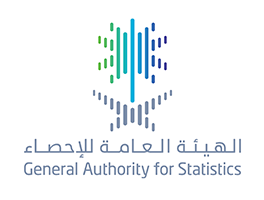
"الصين" الوجهة الرئيسية للصادرات السعودية بقيمة (6693) مليون ريال
Issued its two indicators "exports and imports 10 key partner countries" and the "balance of trade" of Saudi Arabia
"China" the main destination for Saudi exports with a value of SAR (6693) million
On Tuesday Safar 29, 1438H, corresponding to November 29, 2016 the General Authority for Statistics (GaStat) has issued its two indicators: (Trade directions of the top 10 partner countries for exports and imports of Saudi Arabia) and the (balance of trade) until the end of September 2016 on its official website www.stats.gov.sa. The country direction's report considered China as the main distention for exports in Saudi Arabia as the value of Saudi exports to China has reached (6693) million riyals. On the other hand, the (balance of trade) indicator showed a surplus in the Saudi balance of trade in the amount of (22470) million riyals.
The results of the foreign trade directions for the top 10 partner countries in Saudi exports and imports indicator showed that Chins is the main distention for exports in Saudi Arabia as the value of Saudi exports to China has reached (6693) million riyals, making it the main distention for exports, followed by Japan and South Korea with a value of (5913) million riyals and (5106) million riyals, respectively. Unites States, India, United Arab Emirates, Singapore, Taiwan, Netherlands and Bahrain are within the 10 top export destinations. The total amount of Saudi exports to those 10 countries has reached (37709) million riyals, representing (70.6%) of total exports.
In September 2016, the value of imports from the United States has reached (5273) million riyals which makes it in the first place for Saudi imports, followed by China and United Arab Emirates with a value of (4540) million riyals and (1842) million riyals, respectively. Germany, Japan, South Korea, India, Italy, France and Brazil are amongst the top 10 import destinations. The Saudi total imports from these countries has reached (20227) million riyals, representing (65.3%) of total imports.
In its report issued today, GaStat has mentioned the lists of the top 10 exports and imports has been prepared separately, and the top 10 exports/imports countries are the countries with the highest exports/imports values determined by the descending order of countries by the value of exports/imports for the period of study.
In its report, GaStat noted the metadata and used definitions. The report showed that the total exports means the local commodity exports (national exports), and the foreign commodity exports (re-export). The assessment is based on free on board (FOB). The national exports are export of all commodities which has been produced or manufactured locally or has been gone through industrial processes that has changed its shape and value. And re-export concept refers to the exports of formally imported commodities without any obvious amendments. Finally, imports refer to all commodities entering Saud Arabia to meet the local needs after going through customs. Import of services is not included. The assessment is based on the Cost, Insurance and Freight (CIF).
According to GaStat balance of trade, in 2016, the Saudi exports and imports have reached (53423) million riyals and (30953) million riyals, respectively. This led to surplus in the balance of trade in the amount of (22470) million riyals compared to the same month last year (September 2015) which was (6323) million riyals.
In its report of metadata and used definitions, GaStat clarified that the term balance of trade means net exports, which is the difference between exports and imports of the country in certain period of time. This shows if the country has a surplus (exports greater than imports) or a deficit (imports greater than exports) in its foreign trade.
It is worth mentioning, that launch of the two new indicators by GaStat comes within the framework of supporting national development. GaStat announced earlier the launch of more than 45 new statistical products which included: economic, social, demographic Umrah, labour market, energy, knowledge, environment, culture, sports, entertainment, and Security and safety statistics.
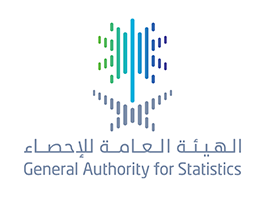
الهيئة العامة للإحصاء : (27.46%) معدل إجمالي الادخار إلى الناتج المحلي الإجمالي في الربع الثاني من 2016م
GaStat: Gross savings rate to GDP in the second quarter of 2016 is (27.46%)
On Thursday 1438 -Safar-24, corresponding 2016-November-24, GaStat has issued the indicator of ( Gross savings rate to GDP) of the second quarter of 2016. It has been published on GaStat official website www.stats.gov.sa. The gross savings rate to GDP of the second quarter recorded an increase of (4.02%) registering (27.36%) compared to the same period of last year in which it registered (26.40%).
Download:Gross Savings for 2nd Quarter 2016 Please click here
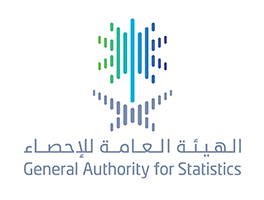
الهيئة العامة للإحصاء تبدأ اليوم بخمسة أعمال إحصائية لدعم التنمية الاجتماعية والاقتصادية
Targeting (33500 HH, (15600 establishments), and lasting for (37) days
GaStat begins five statistical works to support social and economic development
On Sunday 13 Safar 1438 H corresponding 13 November 2016, GaStat starts visiting households and establishments all over Saudi Arabia to implement a number of field works associated with five statistical surveys. Therefore, GaStat asks all citizens and residents either individuals or institutions to cooperate with the statisticians who work in the field in all (13) Saudi regions including cities and governorates. The statistical works will last until 20 Rabe'a first 1438 H corresponding 19 December 2016. These works are targeting more than (33500 HH) and (15600 establishments), and conducted by (650 statisticians).
Taiseer Almufarrij, GaStat spokesman said that the first work will be the labor force survey of the fourth quarter of 2016. This survey will last for 24 days aiming at providing detailed data about the national labor force, measuring the employment and unemployment rates, providing data about the employed and unemployed persons, identifying the employed persons' monthly wage average, in addition to providing data about the employed persons' actual weekly working hours by occupation and economic activity, and data about regular and irregular laborers. The results of these works are essential in making developmental resolutions. However, (Omrah) survey works will begin at the same time of labor force survey works. They aim at building a database about the numbers of Omrah performers, providing accurate statistics about Omrah performers from Saudi Arabia along with foreign Omrah performers to support the 2030 Saudi vision indicators and the developmental resolutions associated with the two holly mosques.
As for the economic statistical works, GaStat spokesman revealed that the economic indicators research works will start during this week. It targets the non-profit public and private establishments. Moreover, the establishments' industrial production research will start, targeting the establishments that work in manufacturing and extractive industries, electricity, gas, and water. This research aims at providing detailed economic data about all establishments. In addition, the direct foreign investment survey will begin, targeting the foreign investment establishments for the purpose of providing detailed economic data about public and private establishments which help in identifying the direct foreign investment indicators in Saudi Arabia.
GaStat confirmed that all data are treated as informational base that developmental resolution makers in all related governmental entities can rely on. It is important to note that all statisticians are holding official cards and are officially charged with collecting data, so that they can be saved and treated with total confidentiality according to the general statistics system issued by the ministers cabinet. Through its website www.stats.gov.sa, the authority gives everyone an opportunity to view the field research forms, depending on which data are going to be collected. All households and establishments are welcome to call us on 8001240440 for any enquiry about these works or any other work.
It is worth mentioning that GaStat are following certified international standards in selecting samples of all its statistical works as they are considered part of the selected statistical community. These samples must represent the studied community. They also must have the community features, so that their results can be published as official statistics on the authority official website.
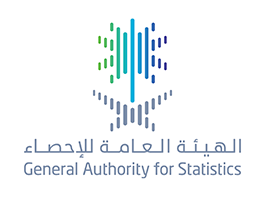
الهيئة العامة للإحصاء تطلق الإصدار الثاني من بوابتها الإلكترونية
5 new features enable the authority clients to get statistical products using Arabic and English languages
GaStat launches the second version of its electronic portal
GaStat launched the second version of its electronic portal www.stats.gov.sa . 5 new features were added to enable the clients from both public and private sectors, decision makers, and researchers to get statistical data, bulletins, and reports issued by the authority in Arabic and English.
The authority asserted that the second version is one of the authority's developmental efforts in providing updated, accurate, comprehensive, and credible statistical products and services that have an added value according to the best international standards and practices.
Through its portal, the authority presents its statistical products and services, so that it becomes a digital database for a lot of developmental fields. The statistics and data come in multimedia and templates that help in supporting the developmental decisions, provide those who are interested in statistics with proper knowledge, and help media in raising the statistical awareness using many interactive windows. The second version was developed to facilitate reaching the indicators and information by focusing on five new features. In this version, there is a new interface for the statistical library which displays the statistical products classified by the product issuance period and issuance periodicity ( monthly, quarterly, or annual). The second feature is the possibility of displaying 35 statistical products. However, the third feature aims at providing statistical products issuance methodologies and field survey forms, so that clients, specialists, academics, and researchers can overview the forms used in the field surveys. As for the fourth feature, it provides a separate section for the statistical products and bulletins' dates of releases. This collaborates in achieving the authority values which include independency and transparency. The fifth feature is the ability to download the products in "Excel" and "PDF" format, so that decision makers, specialists, and researchers can download and use the files to select the appropriate indicators.
It is worth mentioning that GaStat official website was designed in a way that enables everyone to browse it using computers, laptops, tablets, and smart phones.
